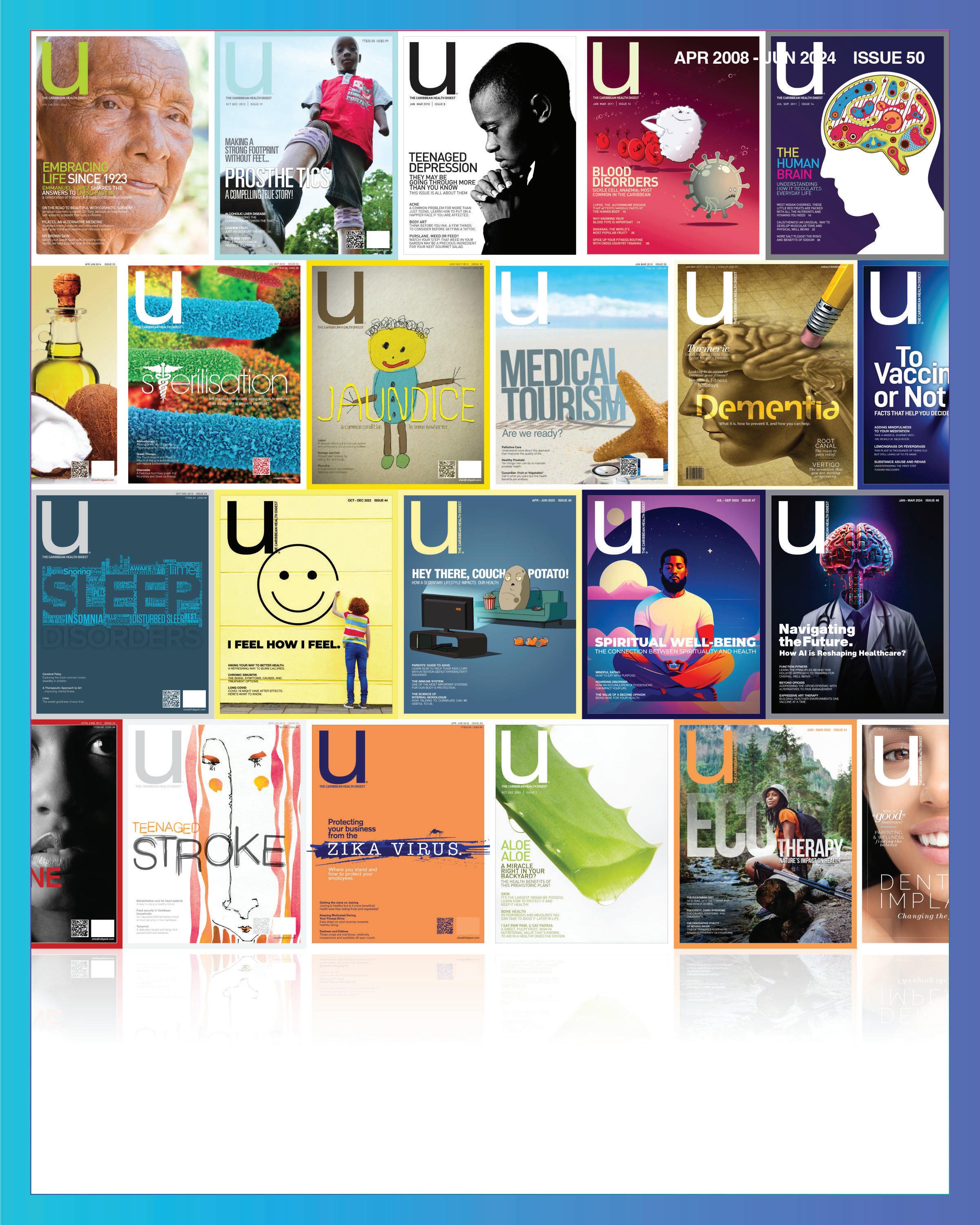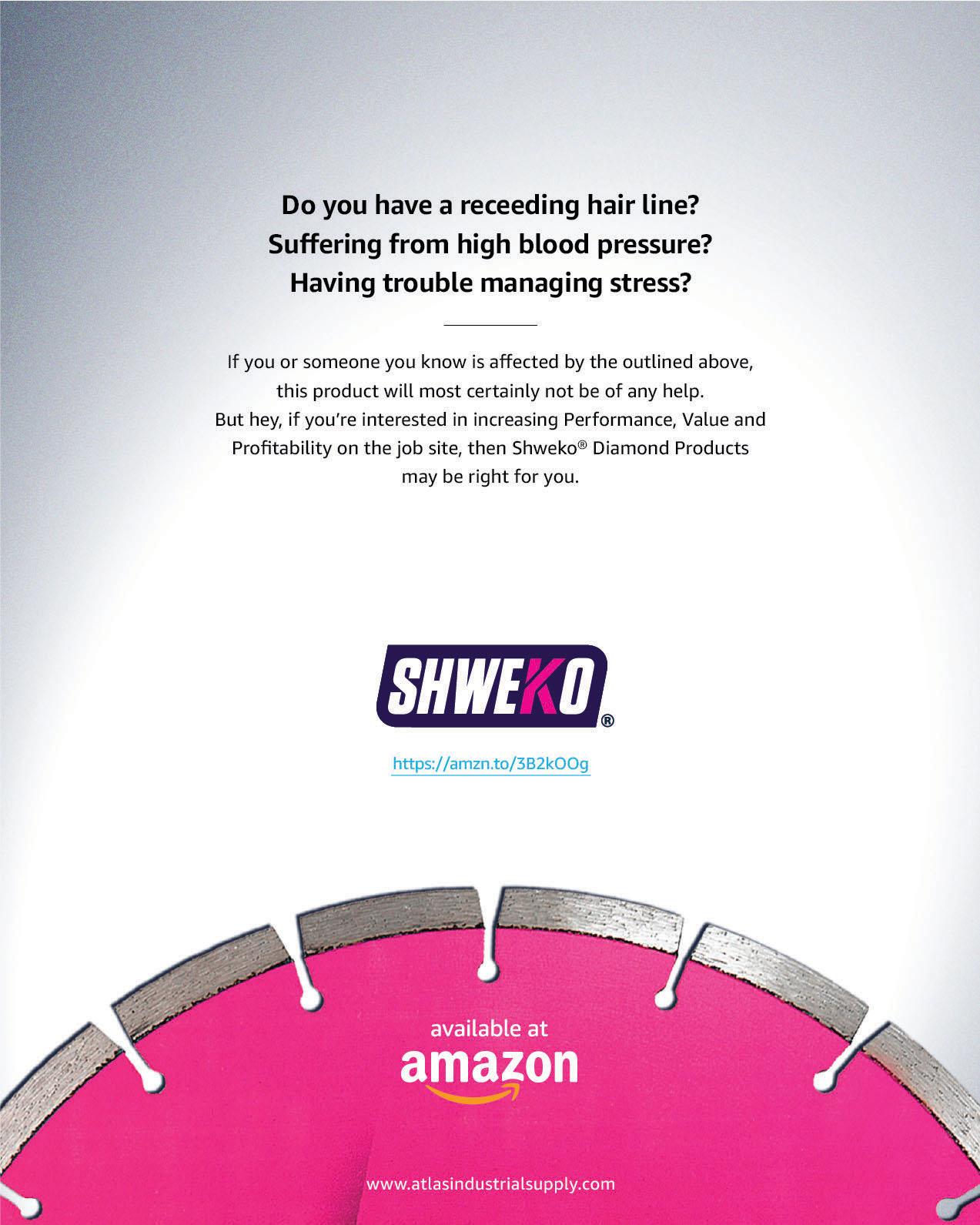

Clouded Judgement The Unfiltered Truth about Vaping
THE DOWNSIDE OF HUSTLE CULTURE WHEN DOING MORE STARTS COSTING YOUR HEALTH.
GREENWASHING IS YOUR WELLNESS ROUTINE AS CLEAN AS IT CLAIMS?
FITNESS FOR EVERY AGE: MOVE SMARTER, FEEL STRONGER AT EVERY STAGE OF LIFE.




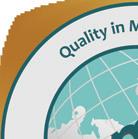
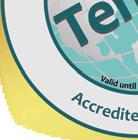



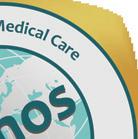












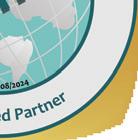

















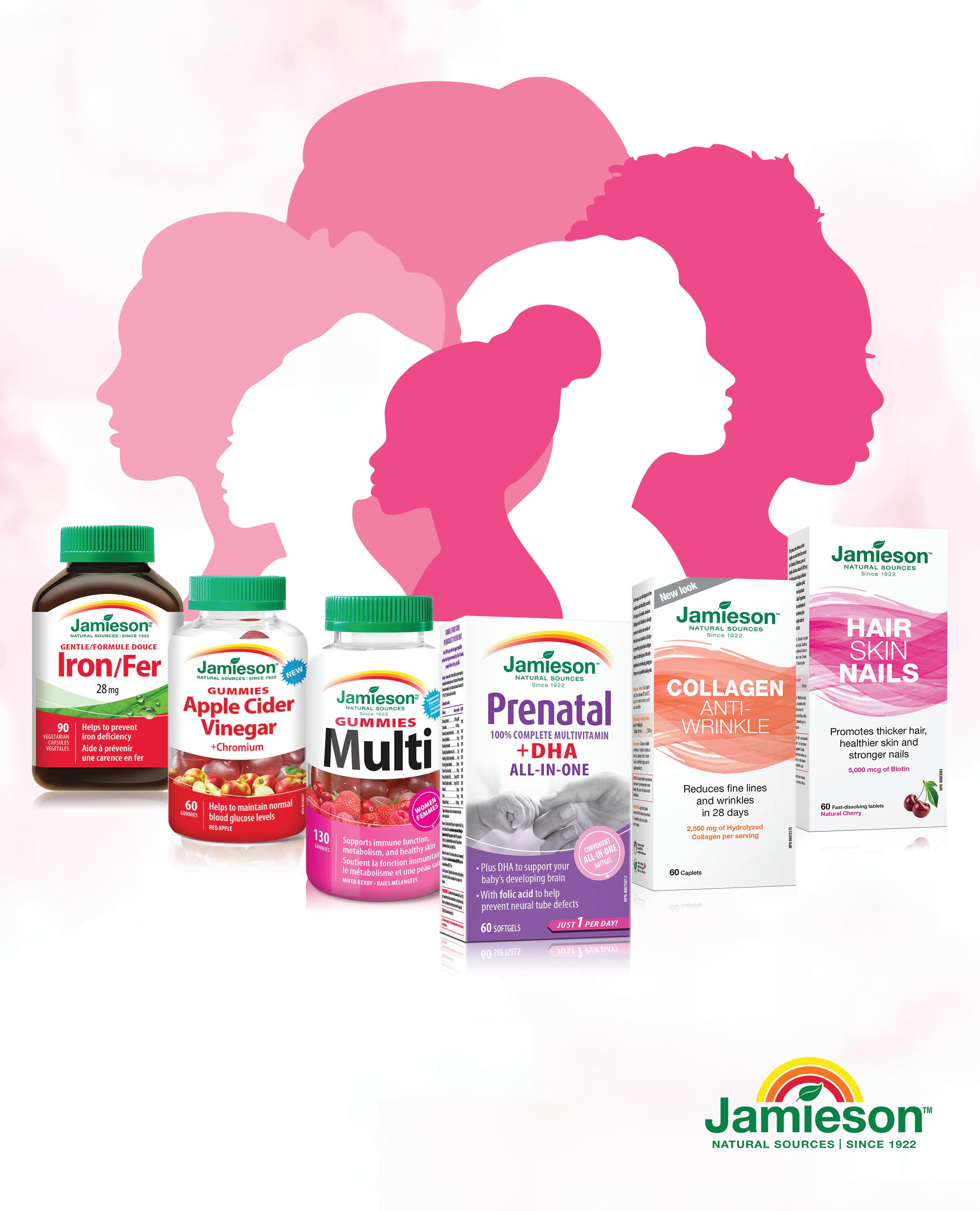




Founders
Sherine Mungal
Stuart Fraser
Editor-in-Chief
Medical Advisory
Writers
Amira Chenelle Mungal
Dr. Jenai Gosine
Abbey Rodriguez
Amira Chenelle Mungal
Andrew Wood
Brandon Pereira
Dr. Jenai Gosine
Maya Reuben
Nathaniel Pinder
Sherine Mungal
Tamara Milano
Creative Director
Design
Project Coordinator
Traffic
Website
Publisher
Photography
Stuart Fraser
Nathaniel Pinder
Eidetic Ltd.
Samantha Dhoon
Samantha Dhoon
Shivan Gosine
Eidetic Publishing
Getty Images
iStockPhoto
Pexels
Freepik
Freepik AI
Midjourney
Vecteezy
Open AI


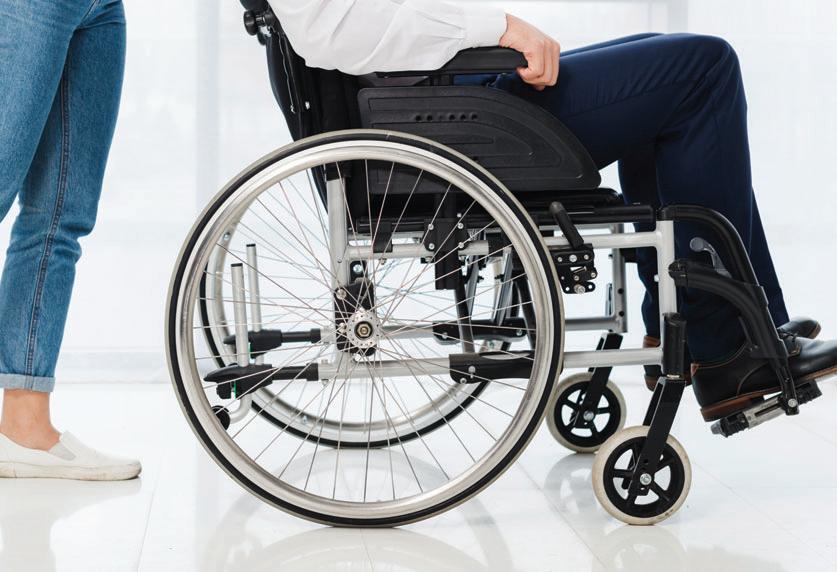

























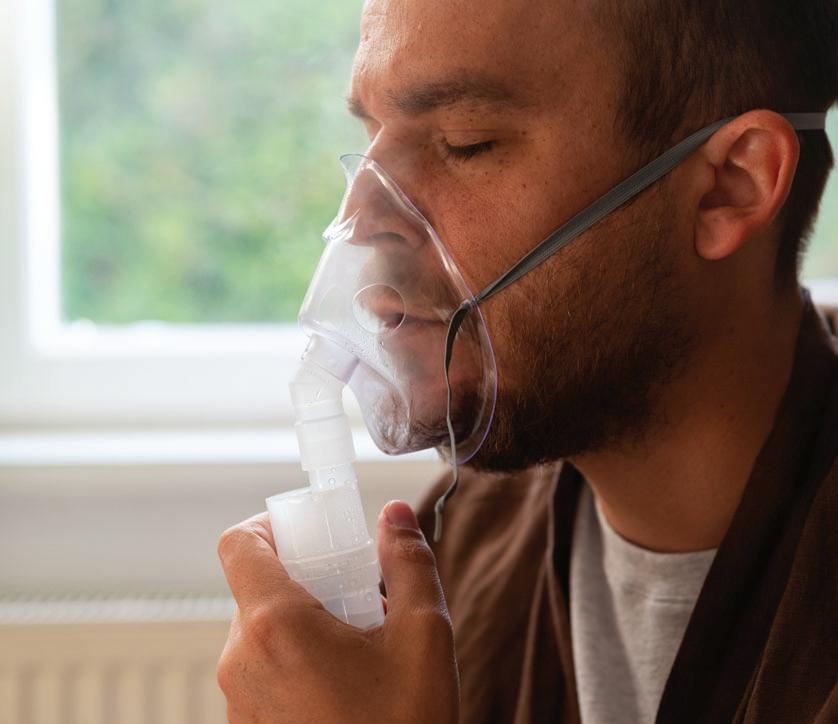


















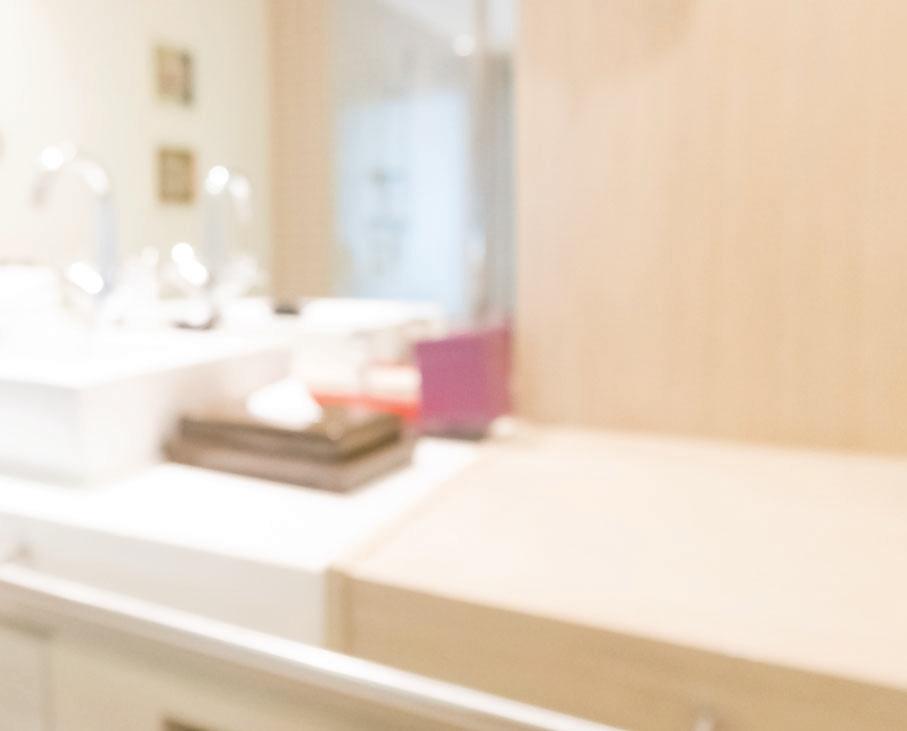
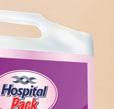





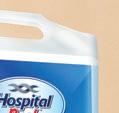


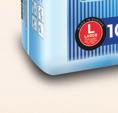
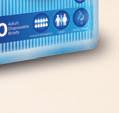



Dear Friends,
We’re delighted to welcome you to this special edition of U The Caribbean Health Digest, created with deep intention and shared pride in the spirit of wellness that continues to energize our region.
As you read this, maybe you’re at the U Health & Wellness Exposition 2025, and you’re part of something bigger. Our magazine, or health and wellness expo, UHWx25, is more than just a magazine or event. It’s a reflection of our collective desire to learn, grow, and create healthier, more connected Caribbean communities.
We are endlessly grateful to our sponsors, exhibitors, and wellness partners whose unwavering support has brought this vision to life. Your commitment makes moments like this possible and meaningful.
What began as a platform has become a movement. With every conversation sparked, product showcased, and idea exchanged, we move one step closer to a region that thrives on knowledge, collaboration, and care. With each year, the expo grows and so do we. In reach, in impact, and in our collective understanding of what it truly means to live well.
Every conversation we spark, every story we tell, and every initiative we support is part of a larger effort to empower people with knowledge and encourage meaningful action. From schools to workplaces to neighborhood groups, we’ve seen how deeply the spirit of wellness is taking root and how small changes can lead to lasting impact.
We truly thank you for being part of this movement. Your continued support, curiosity, and engagement fuel everything we do. We hope this issue brings not just information, but inspiration.
Warm regards,
SHERINE & STUART FOUNDERS
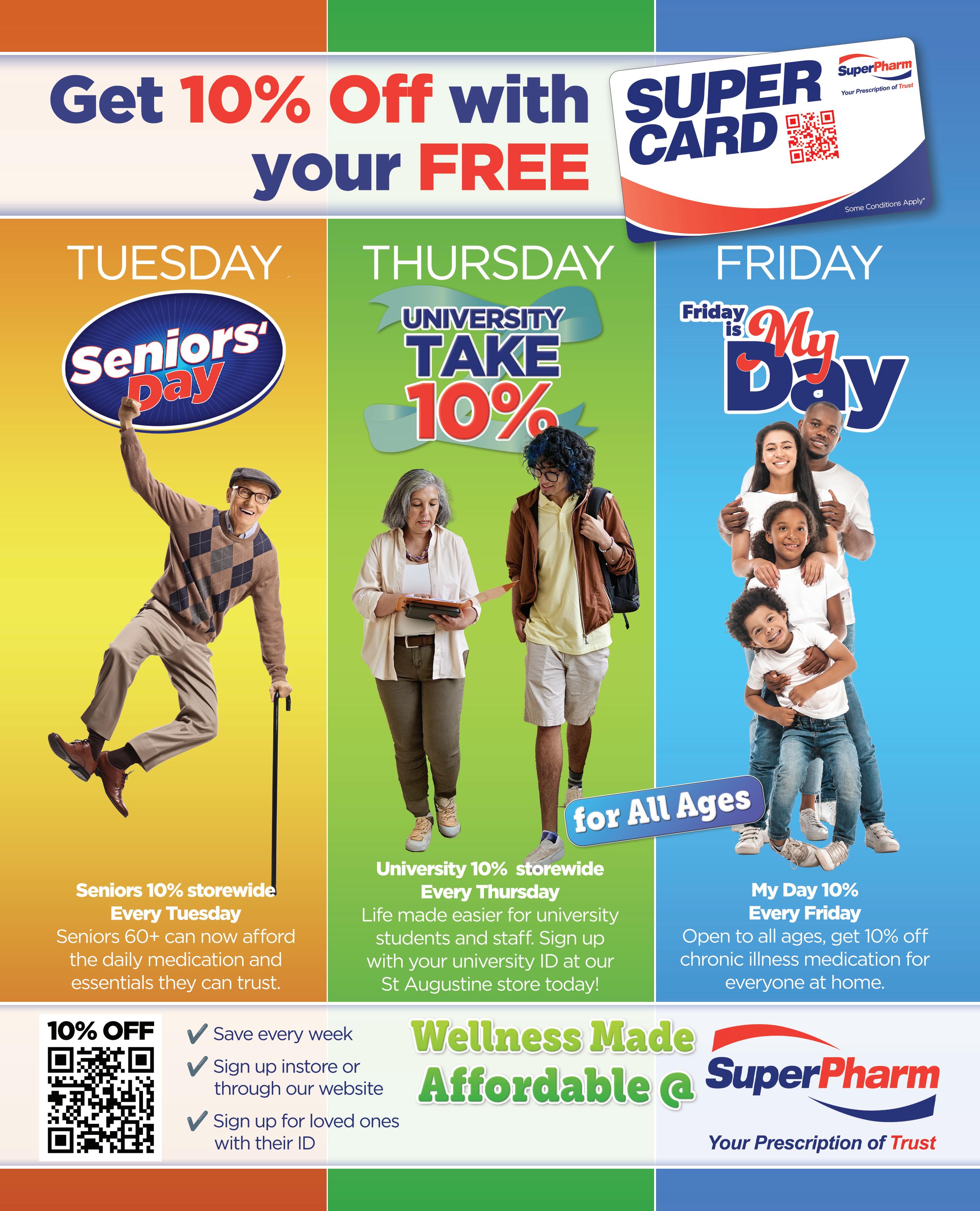

Dearest Readers,
There’s something uniquely energizing about putting together a special edition, especially when we know it will be placed directly into the hands of our community during an event as meaningful as the U Health & Wellness Exposition
This issue holds a mirror up to the many conversations happening across the region right now about what it means to be well, to be informed, and to take ownership of our health journeys. From science-backed stories to everyday wellness insights, we’ve packed these pages with both information and intention.
Our cover story, Clouded Judgment, dives into the growing prevalence of vaping and separates fact from trend, examining the chemicals, the health risks, and the myths shaping public perception. It’s a timely, necessary look at a habit that’s gaining traction, especially among youth.
We also spotlight some of the Caribbean’s most powerful superfoods, decode the marketing trap of greenwashing in wellness, and explore seasonal respiratory illnesses from a regional lens. From thoughtful expert columns to bold “Ten Things” lists, every article was selected to help you reflect, ask questions, and feel empowered.
What makes this issue even more special is that it represents where we’re going, not just as a magazine, but as a movement. We’re growing, connecting, and showing up in print, in person, and in purpose.
To everyone joining us at this year’s expo: thank you for being part of this moment. We hope this issue feels like a conversation with a trusted friend-curious, honest, and deeply rooted in care.
Till next time,
AMIRA CHENELLE MUNGAL EDITOR-IN-CHIEF
The Art of Saying No
Master the power of boundaries with this practical guide to protecting your time, energy, and peace without the guilt.
Clouded Judgment:
The Unfiltered Truth About Vaping
It looks clean. It smells sweet. But what’s really in that cloud? This hard-hitting cover story lifts the veil on vaping from the chemicals you inhale to the marketing tricks targeting Caribbean youth. Backed by science and stripped of spin, it’s everything you need to know before you take the next puff.
Fitness for Every Age:
How to Stay Active Through the Decades
From 20s to 70s and beyond, discover age-appropriate fitness tips to keep your body strong and your mind sharp through every stage of life.
Caribbean Superfoods
Celebrate the region’s healthiest native ingredients from callaloo to turmeric and learn why your next superfood boost could be growing in your backyard.
Seasonal Respiratory Illnesses
Understand how changing weather affects your lungs and learn simple steps to protect your respiratory health year-round.
Hustle Culture
What’s the real cost of “always on” living? We explore how hustle culture impacts mental wellness and how to unplug with purpose.
Focus Without the Frenzy:
L-Theanine’s Quiet Influence
Found in green tea and gaining popularity in supplements, L-theanine may be your secret weapon for calm focus. Here’s what the science says.
Is Your Wellness Routine Green or Just Greenwashed?
Not all “clean” wellness products are created equal. We unpack the deceptive marketing behind greenwashing and how to shop smarter.

A Key to Health and Wellness
WRITTEN BY ADRIANNA CAMPBELL
In today’s fast-paced world, we’re often bombarded with endless demands from work, family, friends, and even ourselves. The ability to say "yes" to everything might seem like a hallmark of productivity and dedication, but it can lead to burnout, stress, and a diminished sense of self-worth. On the other hand, learning the art of saying "no" is an essential skill for maintaining mental, emotional, and physical wellbeing.

WHY SAYING NO IS DIFFICULT
Many of us struggle to say no because we fear disappointing others, damaging relationships, or missing opportunities. Societal and cultural norms often praise those who go the extra mile, even at the cost of their wellbeing. Additionally, people with a strong desire to please or those prone to perfectionism may find it especially challenging to set boundaries.
However, consistently saying "yes" can have detrimental effects. Overcommitting yourself leads to chronic stress, fatigue, and a lack of time for self-care. It’s not just about being overbooked; it’s about how this overextension impacts your overall health.
THE HEALTH IMPLICATIONS OF OVERCOMMITTING
When we say yes to everything, we often sacrifice sleep, exercise, and proper nutrition all of which are pillars of good health. The chronic stress that comes from overcommitting can increase the risk of numerous health issues, including heart disease, anxiety, depression, and weakened immune function.
Moreover, mental health can take a significant hit. Constantly prioritizing others’ needs over your own can lead to feelings of resentment, frustration, and even burnout. The World Health Organization (WHO) recognizes burnout as an occupational phenomenon characterized by emotional exhaustion, cynicism, and reduced professional efficacy. Learning to say no is a powerful tool in combating this.
THE WELLNESS BENEFITS OF SAYING NO
Setting boundaries and saying no doesn’t mean you’re selfish or unkind—it means you value your health and recognize your limitations. When you prioritize your well-being, you’re better equipped to show up for others in a meaningful way.
Here are some key wellness benefits of mastering the art of saying no:
1. Reduced Stress Levels
Saying no allows you to avoid unnecessary stressors and focus on what truly matters. This can lower cortisol levels, improve sleep quality, and enhance overall mental health.
2. Improved Time Management
By declining tasks or commitments that don’t align with your goals, you free up time for activities that support your well-being, such as exercise, hobbies, or spending quality time with loved ones.
3. Enhanced Self-Esteem and Confidence
Each time you set a boundary, you affirm your self-worth. This can boost your confidence and reinforce the belief that your time and energy are valuable.
4. Better Relationships
Ironically, saying no can lead to healthier relationships. When you set boundaries, you prevent feelings of resentment and ensure that your interactions are authentic and mutually respectful.
5. Increased Energy and Focus
Overcommitting spreads your energy thin. Saying no allows you to conserve your energy for tasks and people that align with your values and bring you joy.
PRACTICAL STRATEGIES FOR SAYING NO
Learning to say no takes practice and mindfulness. Here are some strategies to help you master this essential skill:
• Know Your Priorities
Understand your values, goals, and limits. When you’re clear about what matters most, it becomes easier to decline anything that doesn’t align with your priorities.
• Use Positive Language
You can say no without sounding harsh. For example, “I appreciate the offer, but I need to focus on my current commitments” or “That sounds great, but I’ll have to pass this time.”
• Practice Saying No
Start small. Practice saying no in low-stakes situations to build your confidence for more significant decisions.
• Offer Alternatives
If appropriate, suggest another time or a different way to help. For instance, “I can’t help with this project right now, but I’d be happy to review it next week.”
• Give Yourself Time
If you’re unsure, it’s okay to say, “Let me think about it and get back to you.” This gives you space to assess whether the request aligns with your priorities.
EMBRACE THE POWER OF NO
Saying no is a form of self-care that allows you to protect your time, energy, and mental health. By embracing this art, you not only enhance your own well-being but also set an example for others to do the same. Remember, every time you say no to something that drains you, you’re saying yes to something that nourishes you whether it’s rest, creativity, or simply peace of mind. And that’s a choice worth making.






WRITTEN BY BRANDON PEREIRA BRANDONPEREIRA



VAPING HAS BECOME A CULTURAL PHENOMENON; FAST, DISCREET, AND FLAVORED WITH EVERYTHING FROM MANGO ICE TO BUBBLEGUM. MARKETED AS A CLEANER, SAFER ALTERNATIVE TO SMOKING, IT HAS STEADILY MADE ITS WAY INTO SCHOOLS, SOCIAL SCENES, AND HOMES ACROSS THE CARIBBEAN. BUT BENEATH THE SLEEK DESIGNS AND SWEET AROMAS LIES A GROWING PUBLIC HEALTH CONCERN, ONE THAT IS EVOLVING FASTER THAN MOST COMMUNITIES CAN RESPOND TO.


This cover story cuts through the cloud to examine the facts. What does science actually say about vaping? How safe is it, and for whom? And is the Caribbean prepared for the consequences of this rising trend?
A TREND FUELED BY FLAVOR
Vaping’s rapid popularity is no coincidence. The products are designed to appeal with stylish devices, colorful packaging, and an ever-growing list of enticing flavors. These elements have contributed to a global surge in use, particularly among youth. According to the U.S. Centers for Disease Control and Prevention (CDC), flavored e-cigarettes are a major driver of youth vaping, and most young users start with flavored products.
In the Caribbean, where data collection on vaping remains inconsistent, the trend is still evident. Vape shops are multiplying, access is largely unregulated, and products are easily available online. The risk is not only in the products themselves, but in the normalization of their use, especially among teens and young adults, who may see vaping as a harmless lifestyle choice.
THE ILLUSION OF SAFETY
The comparison between vaping and smoking is often used to support the idea that e-cigarettes are “safer.” While it’s true that traditional cigarettes contain thousands of harmful chemicals, many of them carcinogenic, this does not make vaping safe by default. According to the World Health Organization (WHO), e-cigarettes are “undoubtedly harmful” and carry significant health risks, particularly for children, adolescents, and pregnant women.
Vaping liquids typically contain nicotine, a highly addictive substance that affects brain development in young users. In addition, the heating process can release toxic substances, including formaldehyde, acetaldehyde, and heavy metals. Some devices have been shown to deliver higher concentrations of nicotine than combustible cigarettes, raising concerns about addiction and long-term health impacts.
The WHO further warns that while the full effects of long-term e-cigarette use are still being studied, early evidence points to increased risk of cardiovascular disease, respiratory problems, and impaired immune responses.
VAPING AS A GATEWAY
While originally developed as a smoking cessation aid for adults, e-cigarettes have instead become a common entry point into nicotine addiction. The CDC reports that young people who vape are more likely to go on to use traditional tobacco products. This pattern undermines one of vaping’s main arguments: that it helps reduce smoking rates.
Nicotine addiction acquired through vaping can quickly establish a dependency that leads users to seek stronger hits, either through high-nicotine vape products or through combustible tobacco. This trend has sparked concerns globally that a new generation is being introduced to lifelong nicotine use under the false assumption that vaping is a low-risk habit.
A REGULATORY GREY ZONE
In the Caribbean, the regulation of e-cigarettes remains patchy. Some countries have yet to introduce formal legislation governing the sale, distribution, advertising, and use of vaping products. This regulatory vacuum allows for widespread access to unregulated imports, some of which have been found to contain undisclosed or mislabeled ingredients.
Without consistent standards, it becomes nearly impossible to control who has access, what ingredients are being used, or how these products are being marketed. In many jurisdictions, flavored vapes are openly sold near schools, while online retailers operate without age verification. In some cases, products labelled as "nicotine-free" have tested positive for measurable amounts of nicotine, posing serious health risks to unsuspecting users.
Global health agencies, including the WHO and the Pan American Health Organization (PAHO), have urged

member states to implement stricter controls on e-cigarette sales and marketing, particularly those that target young people. Yet, implementation across the region has been slow and uneven.
THE POWER OF PERCEPTION
One of the most challenging aspects of addressing vaping is public perception. Among users, especially youth, vaping is often seen as trendy, harmless, and socially acceptable. Social media has played a significant role in shaping this narrative, with influencers and targeted ads creating an illusion of safety and modernity around vape culture.
Without clear, science-based public education campaigns, misinformation continues to thrive. Many users are unaware that their “nicotine-free” vape may contain addictive substances, or that the flavored clouds they exhale carry volatile organic compounds known to irritate the lungs and bloodstream. The lack of visible consequences in the short term makes it easy to overlook the long-term health implications.
Public health authorities are increasingly calling for educational interventions in schools, community centers, and digital platforms to correct these misconceptions and provide young people with the tools to make informed decisions.
HEALTH IMPLICATIONS: What We Know So Far
Although long-term studies are still ongoing, early evidence paints a worrying picture. According to the CDC and WHO:
• LUNG HEALTH: Vaping has been associated with inflammation of the lungs, reduced lung function, and increased susceptibility to infections. In severe cases, it has led to conditions such as EVALI (e-cigarette or vaping-associated lung injury).
• HEART HEALTH: Nicotine and other chemicals in vape liquids can increase heart rate and blood pressure, contributing to a higher risk of cardiovascular disease.
• BRAIN DEVELOPMENT: For adolescents and young adults, exposure to nicotine can disrupt brain
development, affecting memory, concentration, and emotional regulation.
• CHEMICAL EXPOSURE: Heating vape liquids can produce harmful substances including formaldehyde, acetone, and acrolein compounds known to damage cells and tissues.
The additive nature of vaping’s risks paired with its growing popularity suggests a potential public health crisis in the making.
A CALL FOR ACTION
Addressing the vaping trend requires a coordinated, region-wide approach rooted in public health priorities. Key actions include:
• LEGISLATION AND REGULATION: Enforce age restrictions, regulate product contents, ban flavorings that target minors, and restrict marketing and advertising.
• DATA COLLECTION AND RESEARCH: Invest in local studies to assess the scope and impact of vaping within Caribbean populations.
• PUBLIC AWARENESS CAMPAIGNS: Launch multi-platform initiatives to educate communities, especially youth, about the risks associated with vaping.
• SCHOOL AND COMMUNITY PROGRAMMES: Integrate vaping education into health curricula and support school-wide efforts to reduce use and peer pressure.
• HEALTH SYSTEM PREPAREDNESS: Equip healthcare providers with the tools to screen for and treat nicotine addiction and provide cessation resources for young users.
CLEARING THE AIR
Vaping may be less harmful than smoking, but that does not make it safe. The Caribbean faces a crucial moment in shaping how this issue unfolds. Delay in action risks allowing vaping to become deeply embedded in youth culture, with consequences that could span generations. The time to act is now. Through policy, education, and community engagement, the region can clear the air around vaping and ensure that the health of our people, especially our young people, is not left to chance.

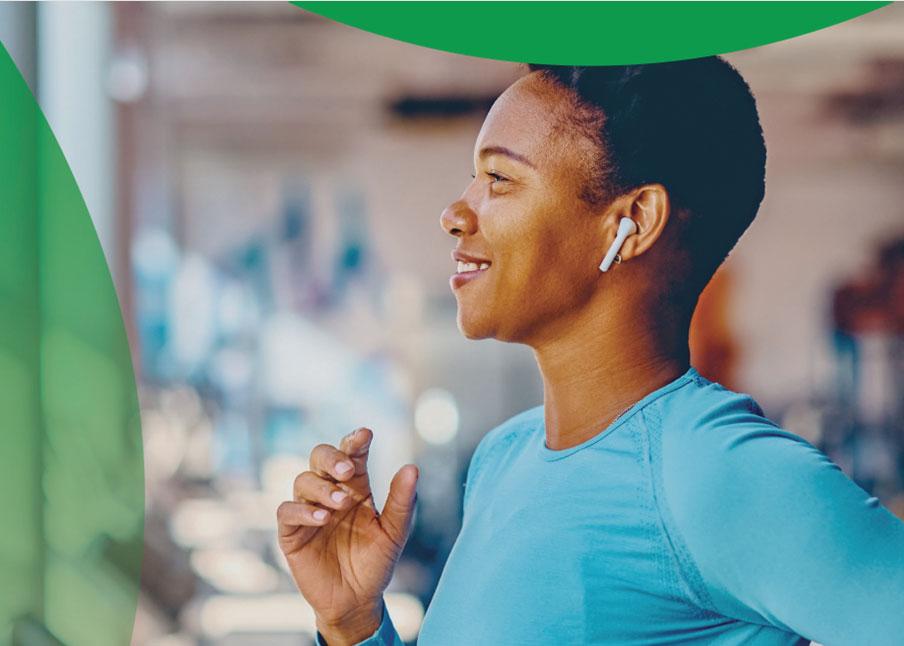
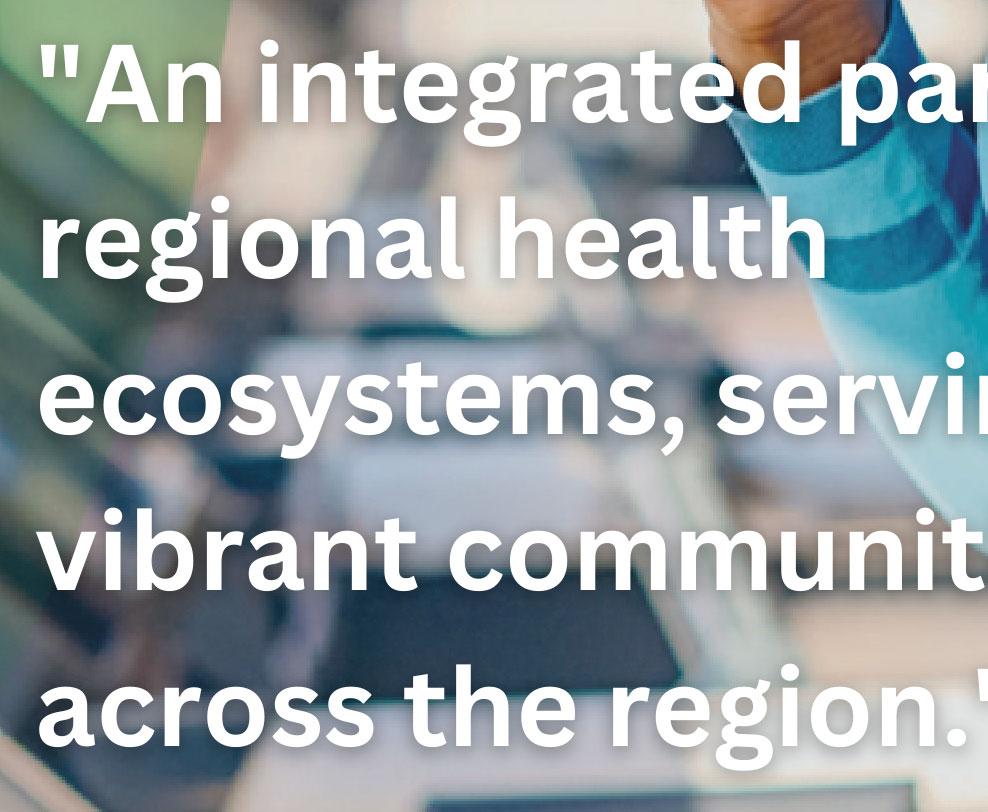










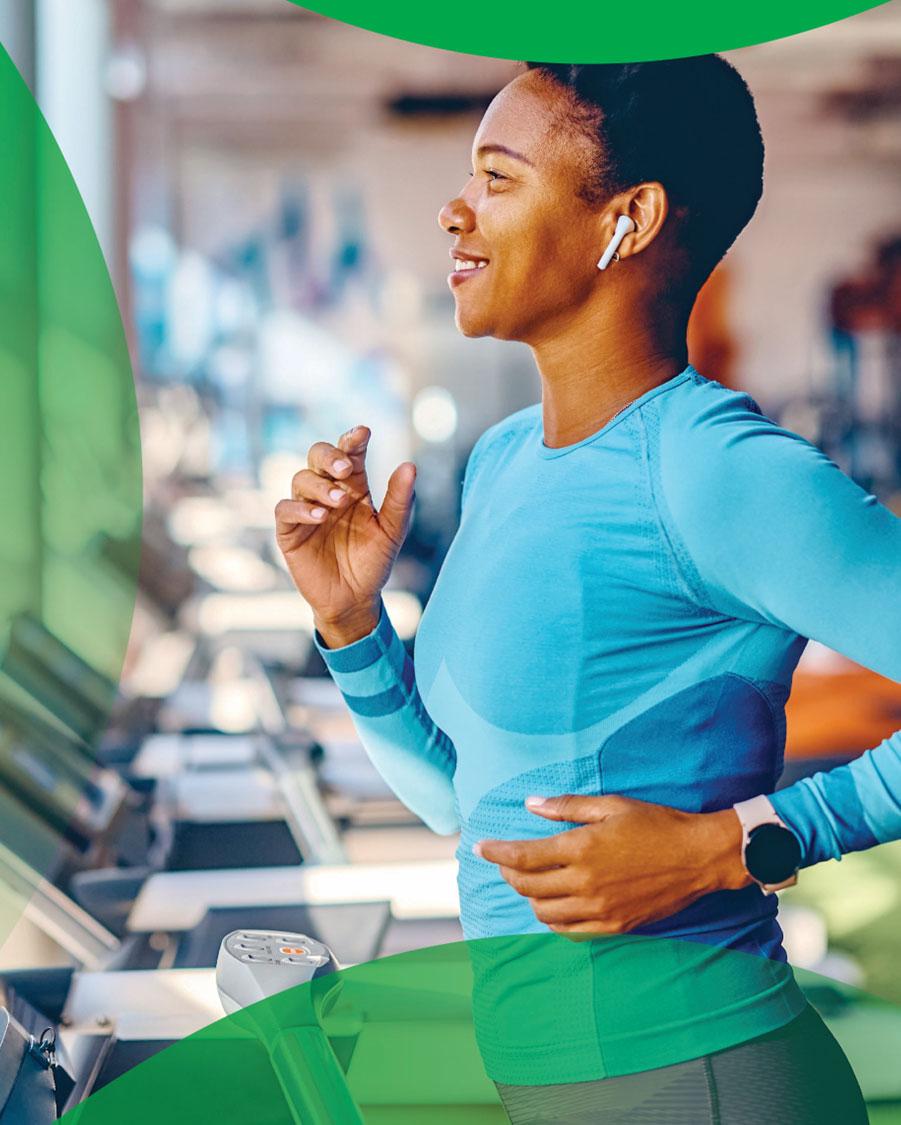
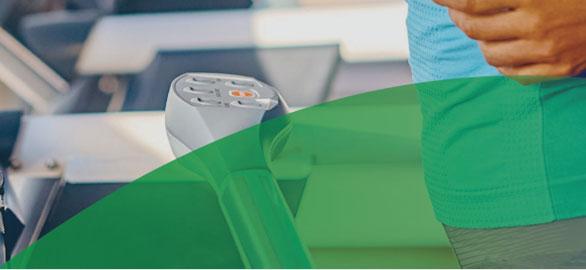


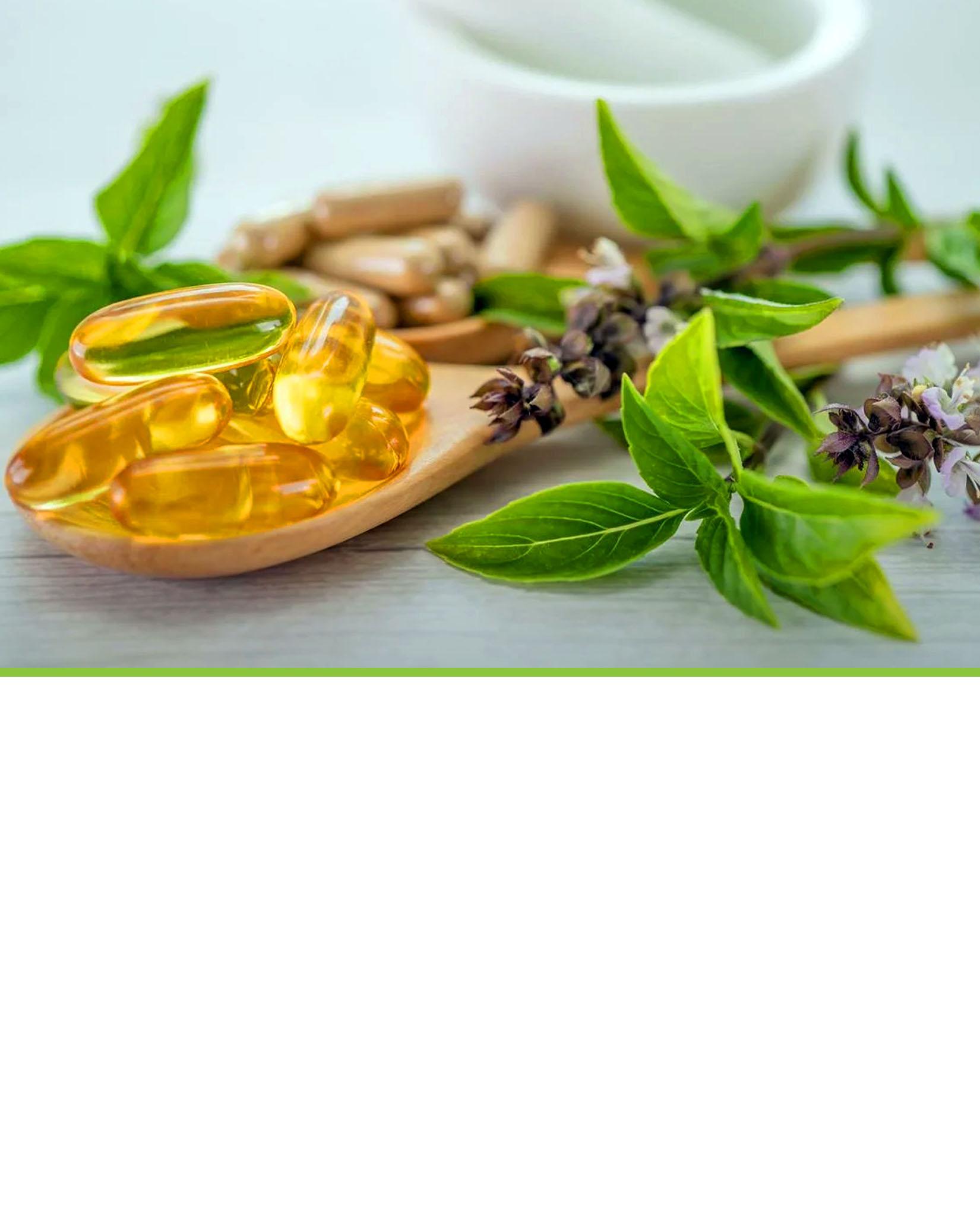


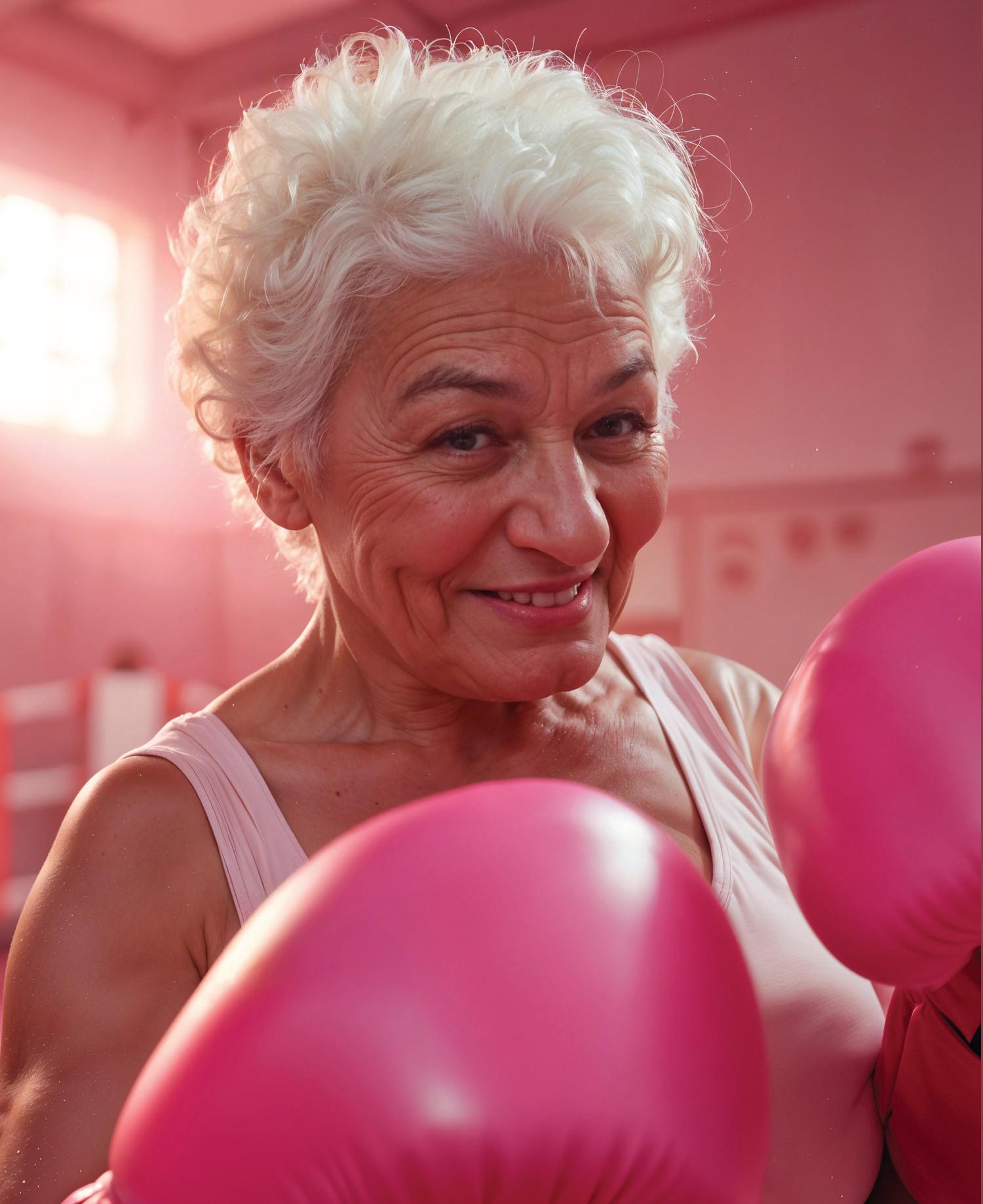
FITNESS FOR EVERY AGE:
HOW TO STAY ACTIVE THROUGH THE DECADES
WRITTEN BY ANDREW WOOD
As a personal trainer, I often hear the same question from clients of all ages: "How can I stay active as I get older?" The truth is, fitness isn't just for the young; it’s for everyone, regardless of age. In fact, maintaining an active lifestyle is crucial for overall health and wellbeing at every stage of life. Let’s explore how you can adapt your fitness routine to match the unique needs of your body as you age.

IN YOUR 20s: BUILDING A FOUNDATION
Your 20s are an ideal time to establish a solid foundation for your future fitness. Your body is resilient and responsive, making it the perfect time to experiment with different workouts and find what you love. Whether it’s weightlifting, running, cycling, or group classes, engage in a variety of activities to build strength, endurance, and flexibility.
KEY FOCUS AREAS:
• STRENGTH TRAINING: Aim for at least two days a week of strength training, targeting all major muscle groups. This builds muscle mass, which naturally declines as we age.
• CARDIO: Incorporate aerobic activities, such as running or swimming, for at least 150 minutes a week. Cardio promotes heart health and boosts endurance.
• FLEXIBILITY: Don’t overlook stretching! Incorporate yoga or dynamic stretches to improve flexibility and prevent injuries.
Establishing these habits early can set the tone for a lifelong commitment to fitness.
IN YOUR 30s: PRIORITIZING BALANCE AND CORE STRENGTH
As you move into your 30s, life often gets busier with work and family responsibilities. It’s essential to carve out time for fitness and focus on balancing strength with core stability.
KEY FOCUS AREAS:
• CORE WORKOUTS: Strong core muscles enhance balance and stability, reducing the risk of injury. Incorporate exercises like planks, bridges, and pilates.
• FUNCTIONAL TRAINING: Choose exercises that mimic everyday movements think squats, lunges, and push-ups. These help maintain strength and coordination for daily activities.
• CROSS-TRAINING: Keep your routine exciting and well-rounded by cross-training with different activities. This helps prevent overuse injuries and keeps you motivated.
Staying active in your 30s can help manage stress and maintain energy levels as life gets hectic, improve flexibility and prevent injuries.
IN YOUR 40S: LISTENING TO YOUR BODY
Entering your 40s often brings new physical challenges, such as slower recovery times and hormonal changes. Now is the time to listen to your body and adjust your fitness routine accordingly.
KEY FOCUS AREAS:
• LOW-IMPACT CARDIO: As joints may become more sensitive, consider low-impact
options like swimming, cycling, or walking to protect your joints while maintaining cardiovascular health.
• STRENGTH TRAINING WITH RECOVERY: Continue strength training, but incorporate more recovery days. Allowing your body to recover is essential for avoiding injuries and improving performance.
• FLEXIBILITY AND MOBILITY: Spend more time on flexibility and mobility exercises, such as yoga or dynamic stretching, to maintain your range of motion and prevent stiffness.
By staying attuned to your body’s signals, you can create a sustainable fitness routine that respects your limits while still pushing you to improve.
IN YOUR 60s AND BEYOND: EMPHASIZING HEALTH AND ENJOYMENT
In your 60s and beyond, the focus shifts from performance to health and enjoyment. Staying active should be about feeling good and maintaining independence.
KEY FOCUS AREAS:
• GENTLE CARDIO: Continue to prioritize cardiovascular health with low-impact activities like walking, swimming, or cycling. Aim for 150 minutes of moderate-intensity aerobic activity each week.
• STRENGTH AND BALANCE: Maintain strength training, focusing on functional movements. Additionally, balance exercises are crucial to preventing falls and maintaining mobility.
• MIND-BODY CONNECTION: Activities like yoga or tai chi can improve flexibility, balance, and mental well-being, fostering a holistic approach to fitness.
Remember, at this stage, the goal is to enjoy movement rather than obsess over performance metrics. Find activities you love, whether it’s dancing, gardening, or walking with friends, and incorporate them into your routine.
FITNESS IS FOR EVERYONE
No matter your age, staying active is essential for your physical and mental health. Remember, fitness is not a one-size-fits-all approach. Tailor your routine to your body’s needs and capabilities. Celebrate your progress, listen to your body, and make fitness a fun and fulfilling part of your life. Every decade brings new opportunities to embrace fitness and enhance your quality of life.
Whether you’re in your 20s or 60s, there’s no better time to start than now. So, get moving, stay motivated, and remember that fitness is truly for every age!












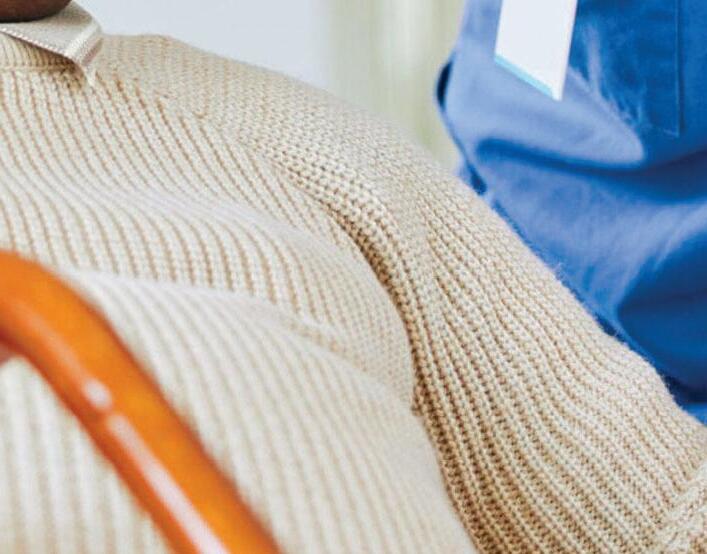








Secure. Connect. Monitor ALL IN ONE SOLUTION.
At Bordertech, we specialize in delivering custom WiFi solutions, robust network infrastructure, and professional surveillance system installations tailored to your unique needs.
WHETHER IT'S A BUSINESS, HOME, OR INDUSTRIAL SITE, WE ENSURE:
Seamless, high-speed connectivity
Smart, scalable network architecture
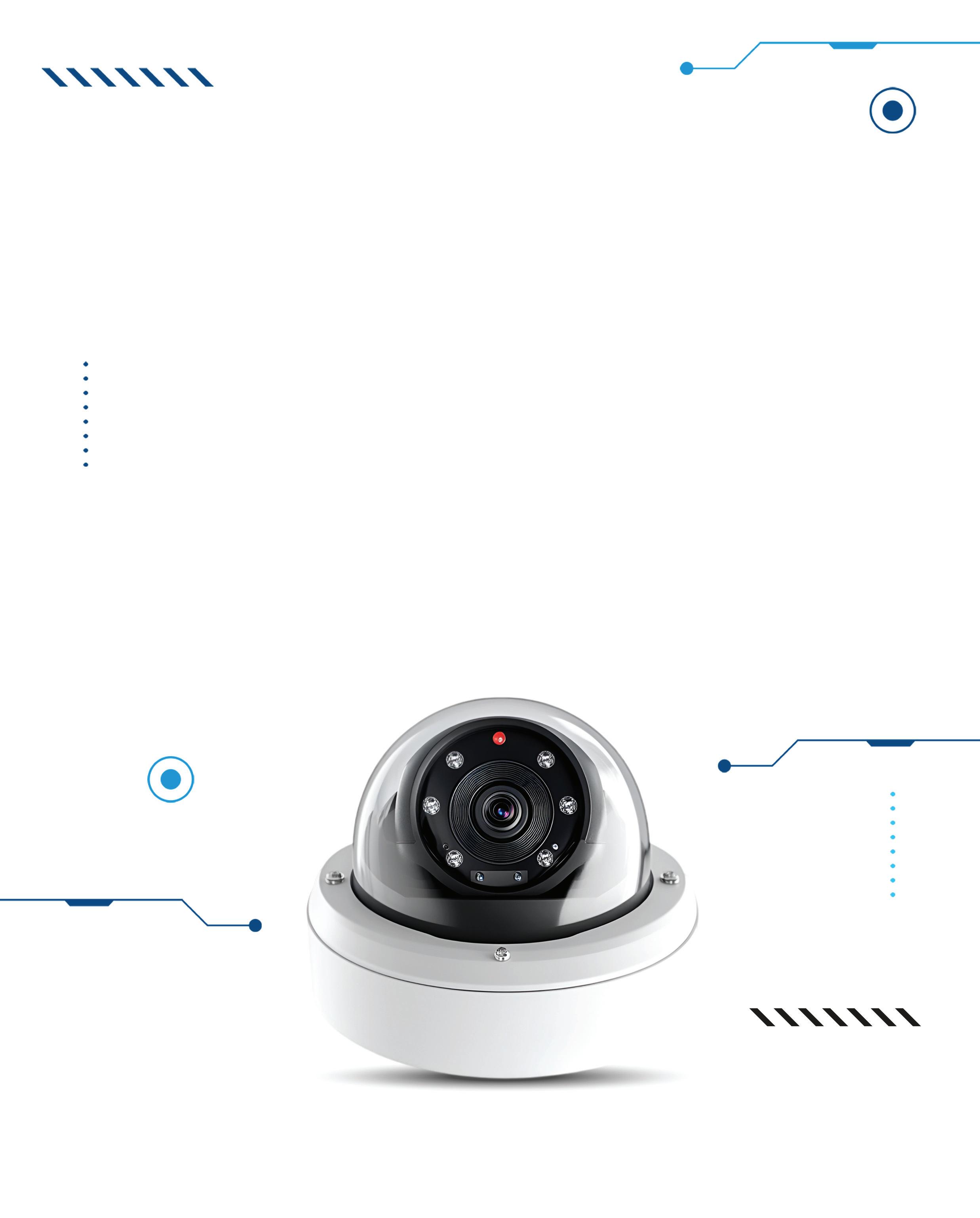
24/7 HD surveillance with remote access
Stay connected. Stay protected. Let us build the tech backbone your space deserves.
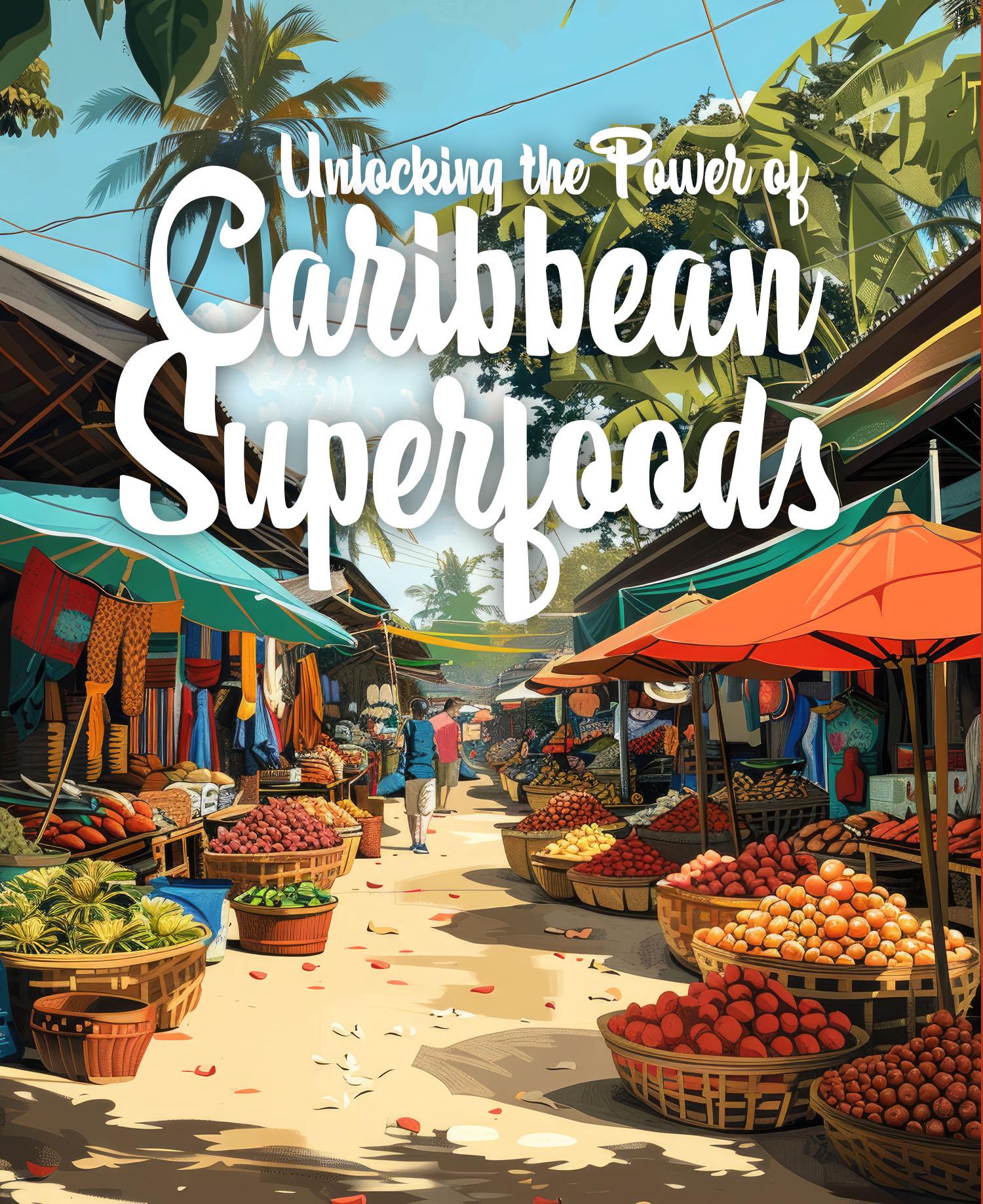
WRITTEN BY MAYA REUBEN

The Caribbean is a region of vibrant cultures, crystal-clear waters, and a culinary heritage as diverse as its people. But beyond the beaches and reggae beats, the islands are home to an array of superfoods packed with health-boosting properties. From energizing fruits to nutrient-dense roots, Caribbean superfoods are as beneficial as they are flavorful.
Moringa: The Miracle Tree
Dubbed "the miracle tree," moringa is a powerhouse of nutrition. Native to parts of Africa and Asia, it has found a welcoming home in the Caribbean. Every part of this plantthe leaves, pods, seeds, and even roots is packed with vitamins, minerals, and antioxidants.
Moringa leaves are particularly prized. Rich in iron, calcium, and protein, they’re an excellent dietary supplement, especially in regions where access to diverse food sources might be limited. Research suggests moringa can help lower blood sugar levels, reduce inflammation, and improve heart health. Whether blended into smoothies, brewed as tea, or cooked in stews, moringa is a nutritional ally worth embracing.
Soursop: Nature’s Cancer Fighter
Soursop, or graviola, is a spiky green fruit with a soft, white, and tangy pulp. Beyond its delicious flavor, soursop is packed with dietary fiber, vitamin C, and B vitamins. However, what sets it apart are its potential anti-cancer properties. Studies have shown that extracts from the soursop fruit and leaves may inhibit the growth of certain types of cancer cells.
In Caribbean households, soursop is often consumed as a juice, ice cream, or tea. But its benefits go beyond indulgence it’s known for promoting relaxation and improving sleep. It’s a fruit that nourishes both the body and the soul.
Breadfruit: The Versatile Staple
Breadfruit, a staple in many Caribbean diets, is often overshadowed by its flashier tropical counterparts. Yet, it deserves the superfood spotlight. This starchy fruit is an excellent source of complex carbohydrates, fiber, and potassium. It’s also gluten-free, making it a great alternative for those with gluten sensitivities.
What makes breadfruit unique is its versatility. It can be roasted, boiled, fried, or even ground into flour for baking. In a world increasingly moving towards sustainable food sources, breadfruit stands out as a climate-resilient crop capable of feeding large populations while delivering essential nutrients.
Turmeric: The Golden Healer
Turmeric, with its vibrant golden hue, has been a staple in Caribbean and Indian cooking for centuries. Known for its active compound curcumin, turmeric is a powerful anti-inflammatory and antioxidant. In Caribbean kitchens, turmeric is used not just for its earthy flavor but also for its medicinal properties.
From soothing joint pain to improving digestive health, turmeric has a wide range of benefits. It’s commonly added to curries, rice dishes, and even teas, offering both flavor and a health boost. As more people seek natural remedies for chronic conditions, turmeric is gaining recognition as a potent superfood.
Ackee: The Brain Booster
Ackee, Jamaica’s national fruit, is often paired with saltfish in one of the country’s most iconic dishes. But ackee is more than just a tasty addition to the breakfast table. It’s rich in healthy fats, particularly omega-3 and omega-6 fatty acids, which are crucial for brain health.
Ackee also contains vitamins A, C, and E, as well as essential minerals like zinc and magnesium. These nutrients support a healthy immune system and contribute to glowing skin. When consumed in moderation and properly prepared (only fully ripe ackee is safe to eat), it’s a superfood that promotes both mental and physical wellbeing.
Callaloo: The Caribbean’s Answer to Spinach
Callaloo, a leafy green vegetable, is a cornerstone of Caribbean cuisine. Similar in taste and texture to spinach, callaloo is loaded with iron, calcium, and vitamins A and C. It’s a must-have for maintaining healthy bones, boosting immunity, and improving eyesight.
Often prepared as a side dish or incorporated into soups, callaloo’s mild flavor makes it easy to incorporate into any meal. Its high fiber content also aids digestion, making it a go-to for those seeking a nutrient-rich, low-calorie food.
Conclusion: A Taste of Wellness
Caribbean superfoods are more than just nutritional powerhouses they are a testament to the region’s rich agricultural heritage and deep connection to the land. By embracing these local gems, we’re not only nourishing our bodies but also supporting sustainable practices and preserving cultural traditions. So, the next time you’re looking to add a boost of health to your diet, look no further than the vibrant, flavorful bounty of the Caribbean.
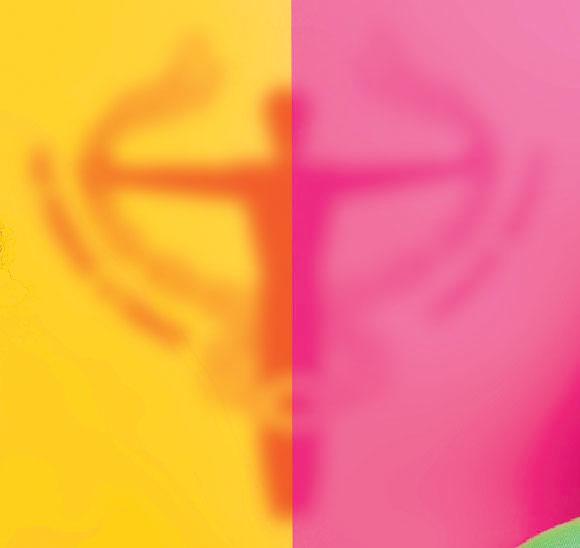
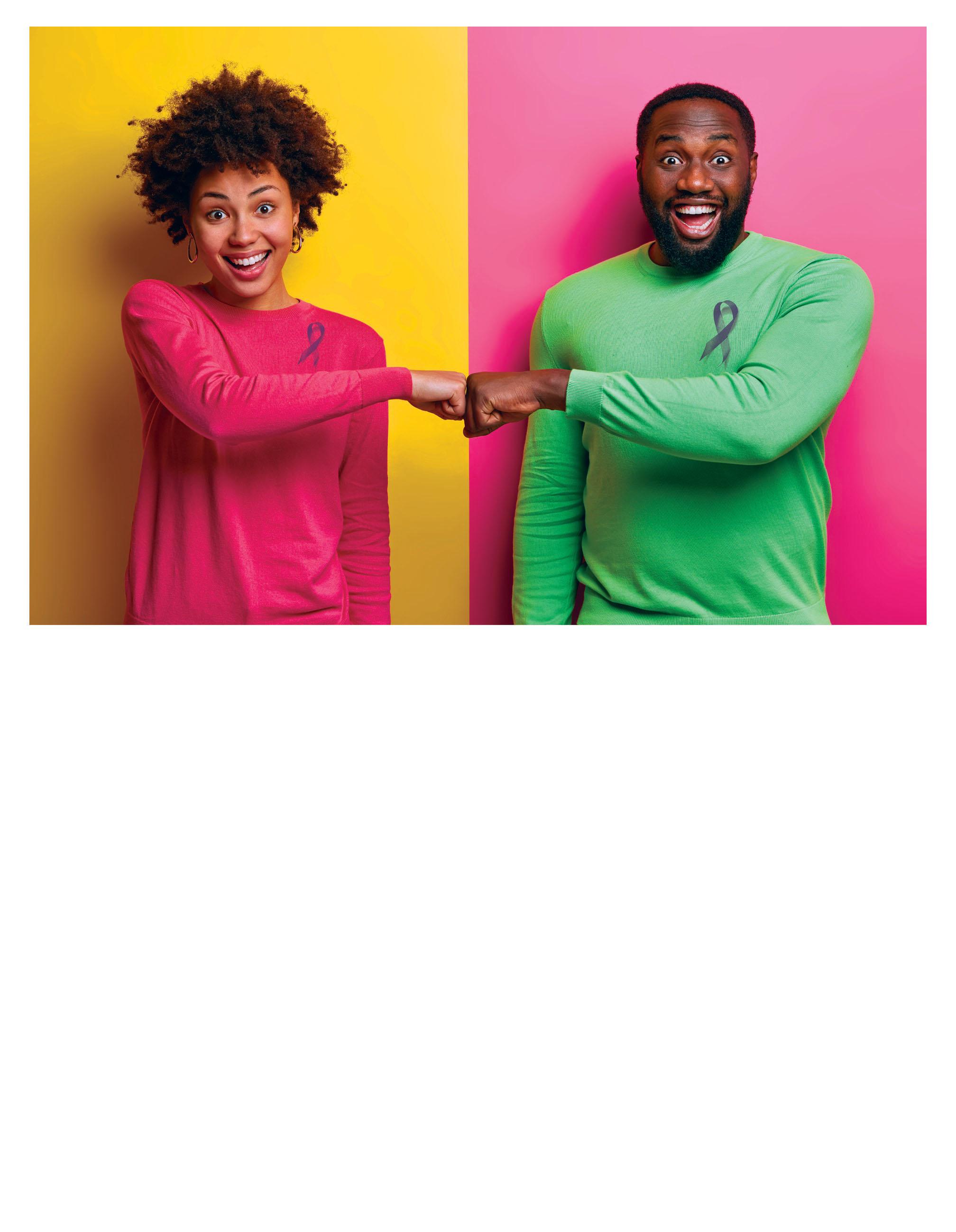
SCREENING
is the first step in winning the fight against cancer.
Cancer is often unpredictable but there is always something you can do to help reduce your risks. The Trinidad and Tobago Cancer Society recommends and promotes screening for early detection of certain cancers.
OUR SCREENING SERVICES INCLUDE THE FOLLOWING:
• Mammograms
• Clinical Breast Examinations
• Pap Smears
• Ultrasounds: Breast, Abdomen, Pelvic, Obstetric, Doppler, Thyroid
• Biopsies
• Prostate Examinations:
- DRE (Digital Rectal Examination),
- PSA (Prostate Specific Antigen)
• Blood Tests
• Consultations
• Fecal Immunochemical Test (FIT)
- A new way to test for colon cancer
These are all conducted at our in-house clinic, outfitted with state-of-the-art equipment, and supported by our highly trained and professional team in a warm and caring environment.
OUR MOBILE CLINIC:
The TTCS also provides Mobile Clinic services throughout Trinidad and Tobago. Our mobile clinics are available by appointment to companies and communities and are fully equipped to conduct Pap Smears, Clinical Breast Examinations, and Prostate Examinations - (Prostate Specific Antigen - PSA )
A nutrient-dense tropical breakfast packed with minerals, fiber, and Caribbean superfoods.
Superfood Star:
Sea Moss – Also known as Irish moss, this powerhouse algae is rich in iodine, zinc, magnesium, iron, and essential amino acids. It supports gut health, immunity, and skin hydration.
Ingredients (Serves 2):
Smoothie Base:
• 2 tbsp sea moss gel (see prep note below)
• 1 cup frozen mango
• 1 frozen banana
• 1/2 cup pineapple chunks
• 1/2 – 1 cup unsweetened almond milk or coconut water (adjust for thickness)
• 1/2 tsp fresh grated ginger (optional for an extra kick)
Toppings:
• Sliced fresh papaya or banana
• Chia seeds
• Toasted coconut flakes
• Pumpkin seeds or granola
• Drizzle of honey or agave (optional)
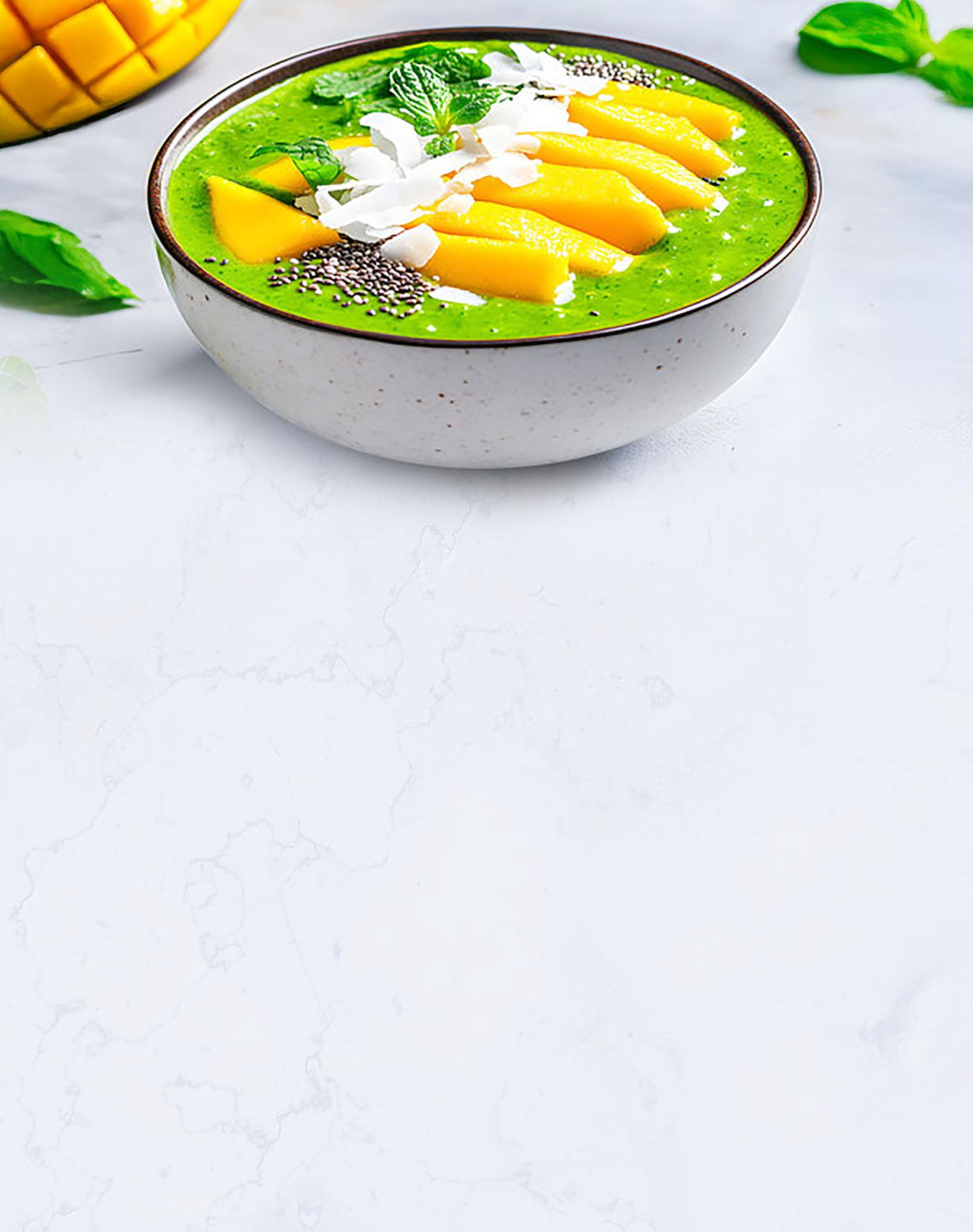
Instructions:
1. Blend the base: In a high-powered blender, combine the sea moss gel, frozen fruits, liquid, and ginger. Blend until smooth and creamy. The consistency should be thick enough to eat with a spoon.
2. Assemble the bowl: Pour the smoothie into a bowl. Top with your choice of toppings.
3. Serve chilled: Enjoy immediately as a filling breakfast, post-workout refuel, or midday energy boost.
How to Prepare Sea Moss Gel:
1. Rinse raw dried sea moss thoroughly to remove sand and debris.
2. Soak in spring or filtered water for 12–24 hours (it will expand significantly).
3. Blend soaked moss with clean water until smooth and gel-like.
4. Store in an airtight container in the fridge for up to 2 weeks. Use 1–2 tablespoons per serving.
RECIPE BY STAFF WRITER
e o l e ir or ll e e
WRITTEN BY DR. JENAI GOSINE

What You Need to Know to Stay Healthy in the Caribbean
When the rainy season rolls in or temperatures begin to shift, many Caribbean households start to experience an all-too-familiar pattern: sniffles, coughs, sore throats, and fevers spreading from one family member to the next. Seasonal respiratory illnesses are a common challenge across the region, and while some are mild, others can lead to serious health complications, particularly for the elderly, young children, and people with chronic conditions like asthma or diabetes.
Understanding how these illnesses spread, what symptoms to look for, and how to protect yourself and your loved ones is essential, especially as viruses like the flu, RSV, and COVID-19 continue to circulate.
Seasonal respiratory illnesses are infections that affect the airways, nose, throat, and lungs and tend to rise during certain times of the year. In the Caribbean, spikes often occur during the rainy season and into the cooler months, when people spend more time indoors and viruses can spread more easily through coughing, sneezing, or close contact.
Common seasonal respiratory illnesses in the region include:
• THE COMMON COLD – Usually caused by rhinoviruses, this infection is mild but spreads easily in households and schools.
• INFLUENZA (Flu) – A more serious viral infection that causes body aches, fever, and fatigue. The flu can lead to complications like pneumonia.
• COVID-19 – Now endemic worldwide, COVID-19 continues to cause seasonal spikes, especially during festive periods and school reopening.
• RSV (Respiratory Syncytial Virus) – Often overlooked, RSV can be dangerous for infants, toddlers, and the elderly, leading to breathing difficulties and hospitalizations.
• SEASONAL ALLERGIES – Triggered by dust, mold, or pollen, allergies can mimic cold symptoms and make respiratory illnesses worse.
Though we enjoy a warm climate year-round, the Caribbean is not immune to seasonal patterns in viral infections. The rainy season, periods of heavy humidity, and cooler nights all contribute to conditions where respiratory viruses thrive. Additionally, our close-knit communities and large gatherings whether for Carnival, Christmas, or Easter create easy opportunities for viruses to spread.
Air conditioning and poor ventilation in many homes and buildings can also trap airborne viruses indoors, especially in schools, offices, or buses where people are in close quarters for extended periods.

While each illness is slightly different, many share similar symptoms. It’s important to monitor for:
• Runny or blocked nose
• Cough
• Sore throat
• Fever or chills
• Fatigue
• Headaches
• Muscle aches
• Shortness of breath or wheezing
Pay close attention to symptoms that worsen or persist beyond a week. If you or a family member has difficulty breathing, persistent high fever, chest pain, or signs of dehydration, seek medical attention immediately.
The good news is that most seasonal respiratory illnesses can be prevented, or their severity reduced with simple steps and good health habits:
1. GET VACCINATED
• Annual flu vaccines are recommended for everyone over 6 months of age and are especially important for pregnant women, seniors, and people with chronic conditions.
• COVID-19 boosters remain crucial for preventing severe illness, especially with new variants still circulating.
• RSV vaccines are now available for older adults and are being rolled out for pregnant women in some countries to help protect newborns.
Check with your local health center or Ministry of Health to find out when and where vaccines are available in your country.
2. WASH HANDS OFTEN
Use soap and water or an alcohol-based sanitizer to wash your hands, especially after coughing, sneezing, or touching shared surfaces. It’s a simple but powerful way to stop the spread of germs.
3. COVER COUGHS AND SNEEZES
Use a tissue or the inside of your elbow-never your hands. Dispose of tissues properly and wash your hands right after.
4. STAY HOME WHEN SICK
Whether it’s a mild cold or suspected flu, staying home when you're unwell helps prevent passing the illness to others at work, school, or church.
5. KEEP INDOOR AIR FRESH
Open windows when possible to improve air circulation. Use fans, air filters, or natural ventilation to reduce the buildup of airborne viruses especially in shared spaces.
In the Caribbean, we’re blessed with natural foods that can help support immune health. To strengthen your body’s defenses:
• Eat a balanced diet rich in local fruits and vegetables like pawpaw, guava, callaloo, and sweet potatoes.
• Get enough rest.
• Stay hydrated, especially in warmer months, by drinking water and natural juices.
• Stay active, even with simple walks or outdoor play.
• Manage stress, which can weaken your body’s ability to fight infections.
Most seasonal respiratory illnesses can be treated at home with rest, hydration, and over-the-counter remedies. But don’t hesitate to seek medical care if:
• Symptoms last more than 10 days or get worse after improving
• You or your child have a high fever that won’t break
• Breathing becomes difficult or wheezing develops
• There is extreme tiredness, confusion, or chest pain
• If you have asthma, COPD, heart disease, or diabetes, speak to your doctor early when symptoms arise, as complications can escalate quickly.
Seasonal respiratory illnesses are a part of life, but they don’t have to disrupt your health or your household. With good habits, community awareness, and access to vaccinations, we can reduce the spread and severity of these illnesses across the Caribbean.
Whether it's a simple cold or something more serious, staying informed and proactive is the first step in protecting yourself and those around you.
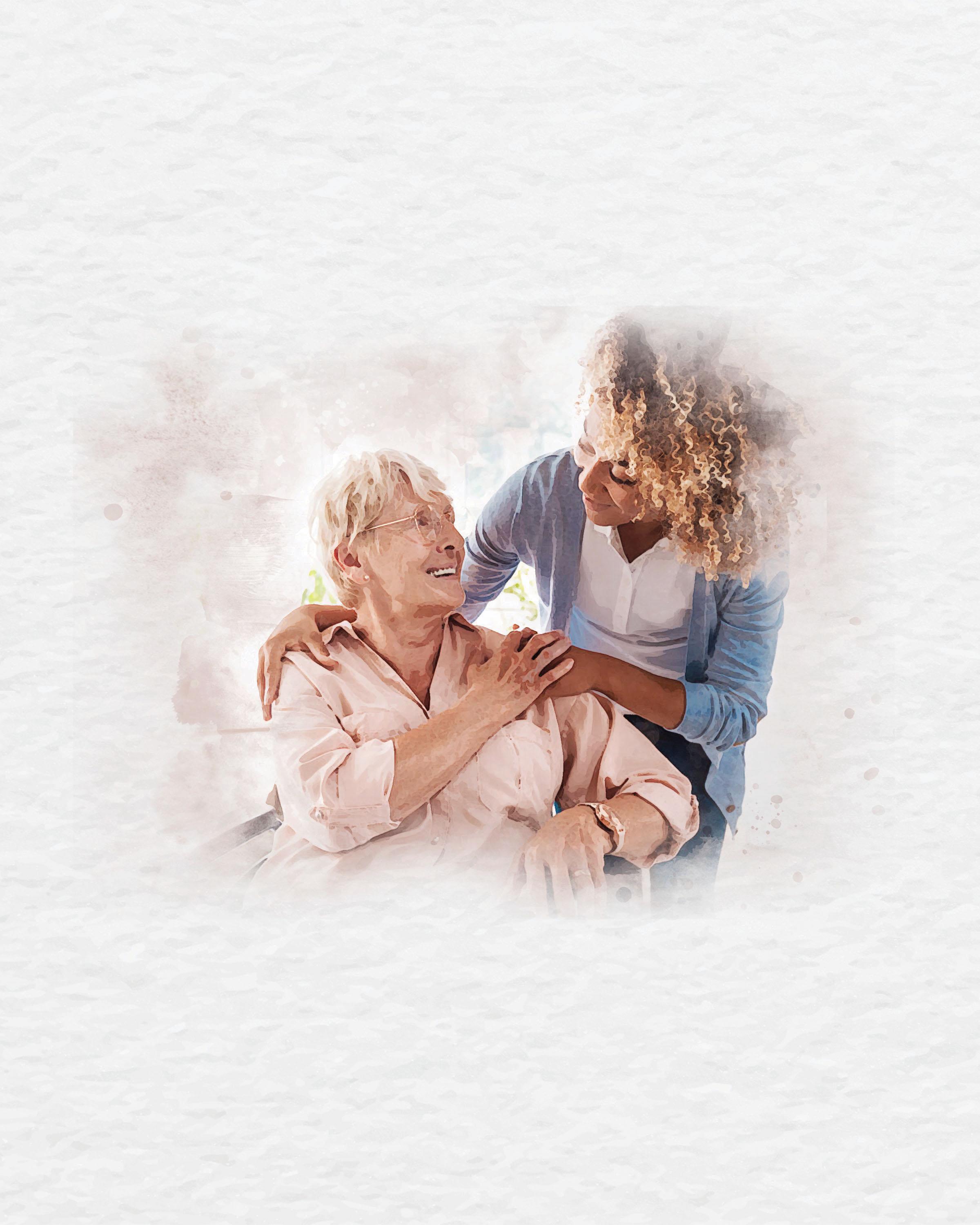
At A.V.A Assisted Care Living, we strive to create a warm and welcoming home for our residents. Our experienced staff is committed to providing personalized care and attention to each individual. Whether you’re here for short-term or long-term care, we’re here to make sure you feel at home and at ease. Let us take care of
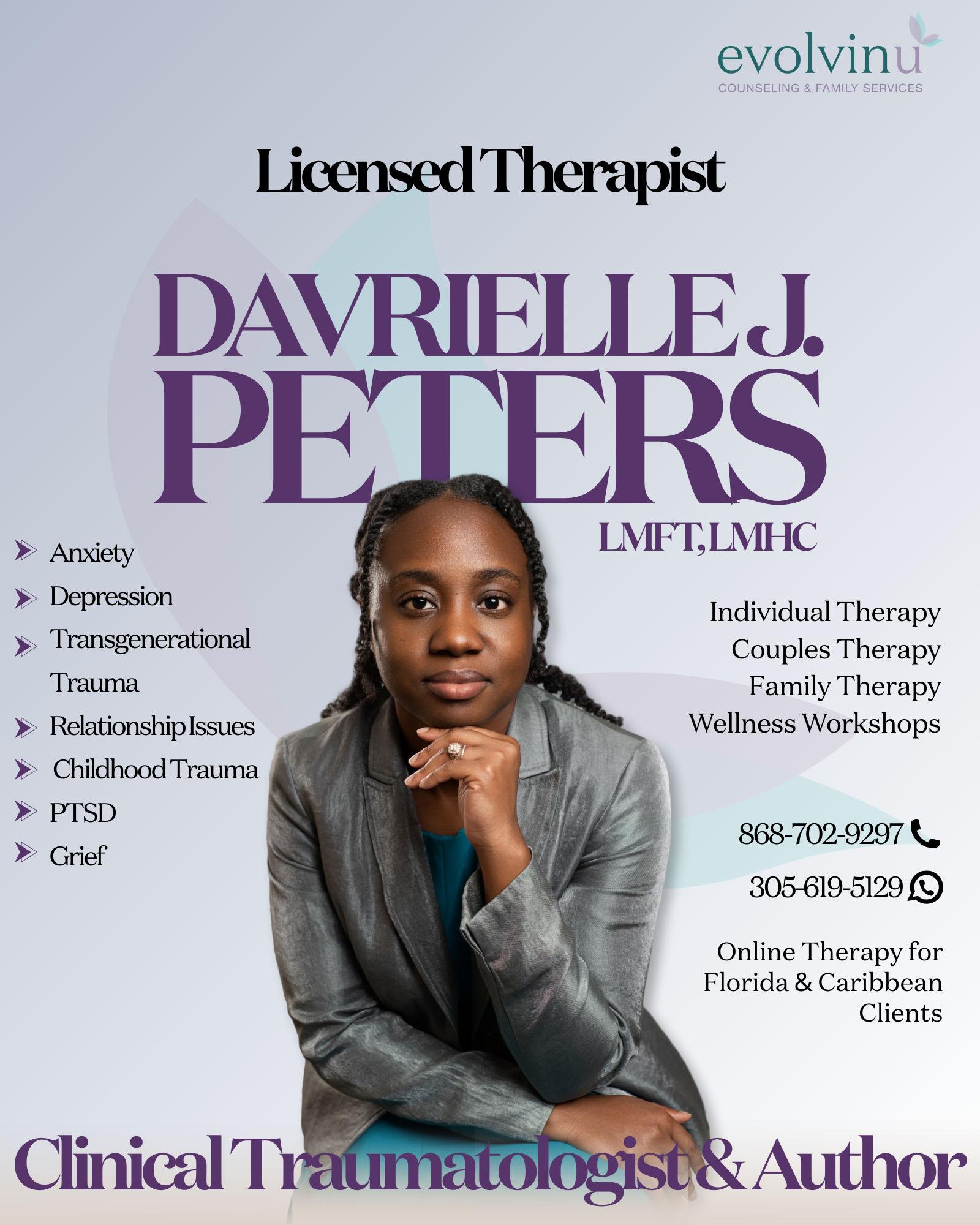
The mantra of “hustle hard” has become a badge of honor. Hustle culture glorifies constant work, celebrates sleepless nights, and pushes individuals to achieve faster. It’s the idea that success comes only to those willing to sacrifice everything, time, health, and relationships for their goals. While this mindset has driven innovation and achievement, its toll on health and wellbeing is becoming increasingly apparent.
THE ALLURE OF HUSTLE CULTURE
Hustle culture is deeply embedded in modern society, particularly in the age of social media. Platforms like Instagram, LinkedIn, and TikTok showcase entrepreneurs, influencers, and professionals who seem to be “grinding” 24/7. The message is clear: if you’re not working, you’re falling behind.
This relentless pursuit of productivity often stems from societal pressures to achieve financial security, status, and personal fulfillment. The fear of being left out or labeled as lazy drives many to adopt a non-stop work ethic, even at the expense of their health.
THE PHYSICAL IMPACTS
The human body is not designed to function at full throttle indefinitely. Prolonged exposure to stress, often chronic stress, is one of the most immediate consequences of hustle

culture. When we’re constantly in “go” mode, the body produces excess cortisol, the stress hormone. Over time, this can lead to a host of physical health issues, including:
• Cardiovascular Problems: Chronic stress increases the risk of high blood pressure, heart disease, and stroke.
• Weakened Immune System: Constant stress can suppress immune function, making individuals more susceptible to illnesses.
• Sleep Disorders: The hustle mentality often glorifies minimal sleep, but poor sleep hygiene can lead to insomnia, fatigue, and impaired cognitive function.
• Digestive Issues: Stress can exacerbate gastrointestinal problems, such as irritable bowel syndrome (IBS) or acid reflux.
THE MENTAL AND EMOTIONAL TOLL
Beyond the physical consequences, hustle culture takes a significant toll on mental health. The constant pressure to achieve can lead to:
• Burnout: Characterized by emotional exhaustion, depersonalization, and a reduced sense of personal accomplishment, burnout is a direct result of prolonged overwork.
• Anxiety and Depression: The fear of failure and relentless self-comparison can trigger severe anxiety and depressive episodes.
• Loss of Identity: When individuals tie their self-worth solely to their productivity, they risk losing sight of who they are outside of work. This can lead to feelings of emptiness and a diminished sense of purpose.
SOCIAL AND RELATIONAL STRAIN
Hustle culture often isolates individuals from their support systems. The emphasis on work leaves little time for meaningful relationships, leading to:
• Strained Personal Relationships: Friends, family, and partners may feel neglected, causing friction and emotional distance.
• Erosion of Social Bonds: Social activities and community engagement are sacrificed, leading to loneliness and a lack of emotional support.
REDEFINING SUCCESS
To counter the damaging effects of hustle culture, society needs a fundamental shift in how success is defined. Achievements are important, but not at the cost of one’s health and happiness. Embracing a more balanced approach requires:
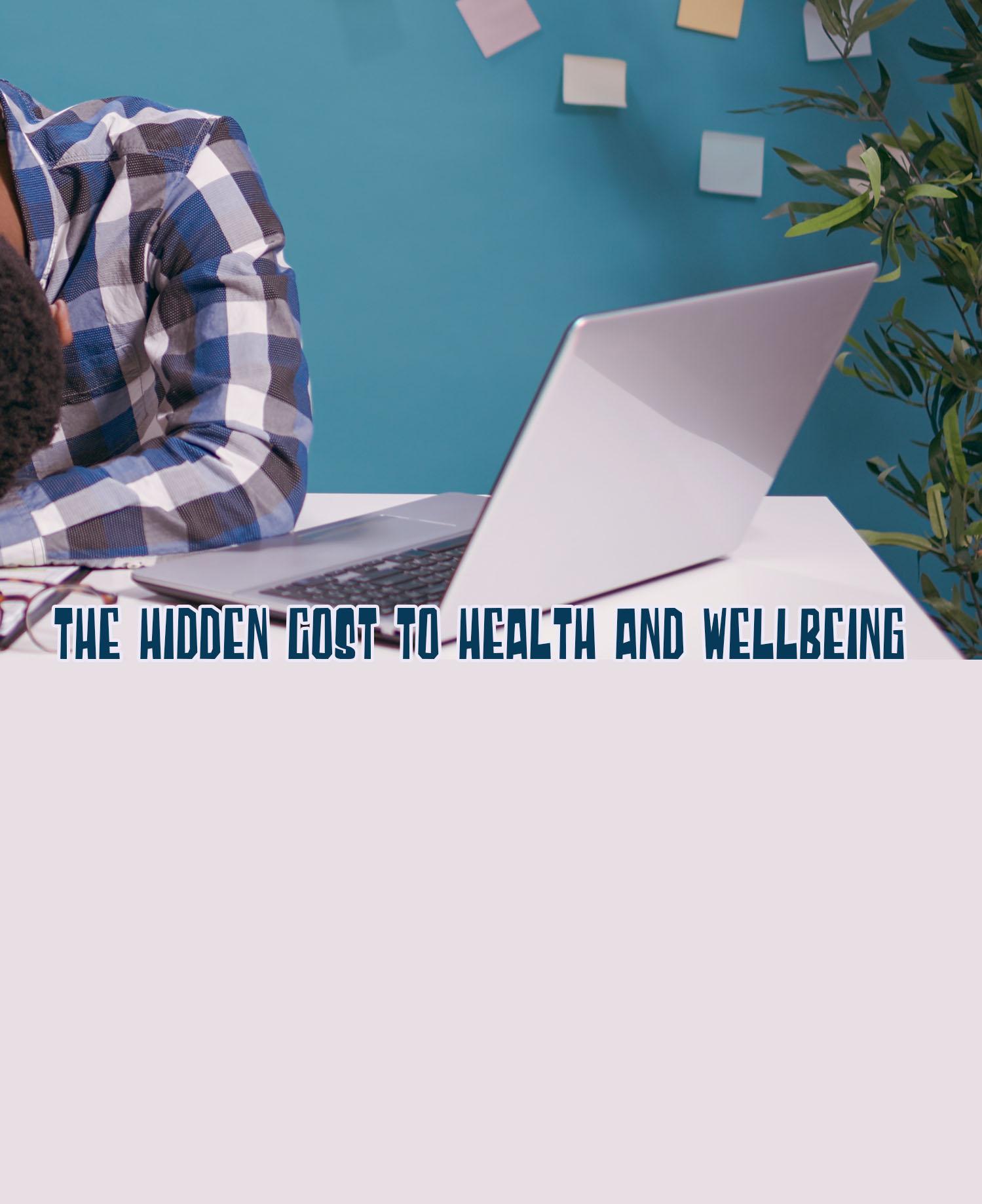
• Prioritizing Self-Care: Regular exercise, adequate sleep, and healthy eating should be non-negotiables. These are not luxuries but essentials for sustained productivity and wellbeing.
• Setting Boundaries: Establishing clear boundaries between work and personal life helps prevent burnout. This might mean disconnecting from work emails after hours or taking regular vacations without guilt.
• Valuing Rest: Rest and downtime are crucial for mental clarity and creativity. The idea that rest equals laziness needs to be debunked.
• Seeking Support: Whether through therapy, coaching, or peer support groups, talking about stress and challenges can alleviate the mental burden.
THE WAY FORWARD
Hustle culture may promise success, but it often delivers exhaustion. It’s time to reject the notion that our worth is defined by our output. Health and wellbeing should be prioritized, not sidelined, in the pursuit of achievement. By embracing balance, individuals can lead more fulfilling lives—proving that sustainable success is possible without sacrificing one’s physical, mental, and emotional health.
WRITTEN BY ABBEY RODRIGUEZ


Focus Without the Frenzy
L-Theanine’s Quiet Influence


WRITTEN BY NATHANIEL PINDER WRITTENBY NATHANIELPINDER

If you’ve ever sipped on a cup of green tea and felt oddly calm yet mentally sharp, you might have experienced the magic of L-theanine, an amino acid quietly helping people chill out without zoning out.
L-theanine is one of those natural compounds that’s been flying under the radar, but once you hear what it can do, you’ll wonder why more people aren’t talking about it. So, let’s break it down: what is L-theanine, why are people using it, and what can it do for you?
Meet L-Theanine, Your Brain’s Chill Pill
L-theanine is a unique amino acid found mainly in tea leaves, especially green and black tea. It was discovered in Japan in the late 1940s, and ever since, scientists have been fascinated by how it interacts with the brain.
Unlike other amino acids your body uses to build proteins, L-theanine has a different job. It works behind the scenes in your brain, helping regulate mood, focus, and stress levels. It’s like caffeine’s mellow cousin, no buzz, just smooth, steady, calm.
Why Do People Take It?
L-theanine is mostly used to help with:
• Relaxation without making you sleepy
• Better focus and mental clarity
• Stress and anxiety relief
• Improved sleep quality
• Balancing out caffeine jitters
You can get it naturally from drinking tea (especially green tea), but if you’re looking for a bigger dose or more noticeable effects, it’s also available in supplement form, usually as capsules, powders, or part of nootropic blends. Some people even take it alongside their morning coffee. Why? Because L-theanine and caffeine make an awesome team: caffeine wakes you up, L-theanine keeps you calm and focused. It’s like getting energy without the edge.
The Perks Without the Pitch
Here’s what the research and tons of happy users say L-theanine can do:
1. Chill Mode: Activated. Nap Mode: Denied. One of the coolest things about L-theanine is that it helps calm your mind without making you feel drowsy. It boosts alpha brainwaves, the same ones you get when you’re meditating or in a state of relaxed alertness. So, you stay clear-headed, not spaced out.
2. All the zoom, none of the boom. On its own or paired with caffeine, L-theanine can help you lock in and concentrate. People report feeling more “on” and less easily distracted. This makes it a favourite for students, professionals, and anyone who needs to get stuff done without burning out.
3. Like bubble wrap for your nervous system. If you’re the type who feels a constant undercurrent of stress or worry, L-theanine might take the edge off. It seems to increase calming brain chemicals like GABA, serotonin, and dopamine, all of which help regulate mood and make you feel more balanced.
4. Sleep like a baby, wake like a boss. L-theanine doesn’t knock you out like melatonin or prescription sleep aids, but it can help quiet a busy mind, so you fall asleep more easily. It’s especially useful for people who have trouble sleeping because of stress or overthinking.
5. Like a helmet for your brain, minus the hat hair. There’s some early research suggesting that L-theanine may also help protect your brain as you age, thanks to its antioxidant properties and ability to support healthy brain chemistry. More studies are needed, but it’s a promising area.
Should You Be Worried? (Spoiler: Probably Not)
L-theanine is considered very safe, with most people taking doses between 100 and 400 mg per day. It doesn’t build up in your system or cause dependency, and side effects are super rare. Still, if you’re pregnant, breastfeeding, or on medications for mood or sleep, it’s always smart to check with your doctor first.
Some Food for Thought (see what I did there, sorry)
L-theanine might not have the flashy reputation of some other supplements, but it’s seriously underrated. Whether you want to feel less frazzled, focus better at work, or wind down at night without grogginess, it’s a gentle but effective tool.
And the best part? You don’t have to overhaul your routine to try it. Start with a cup of quality green tea or grab a supplement and see how it makes you feel. Sometimes the smallest shifts make the biggest difference.
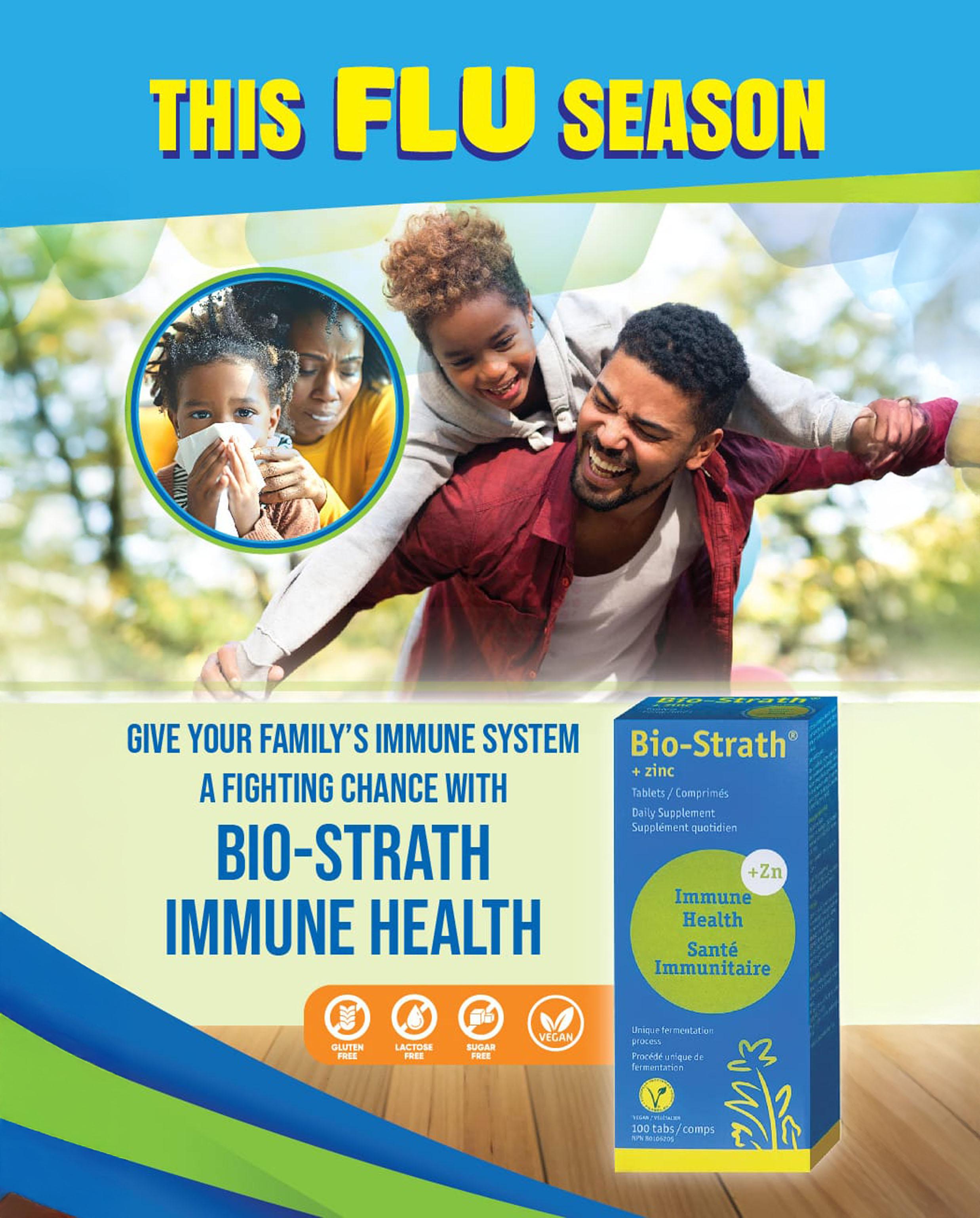
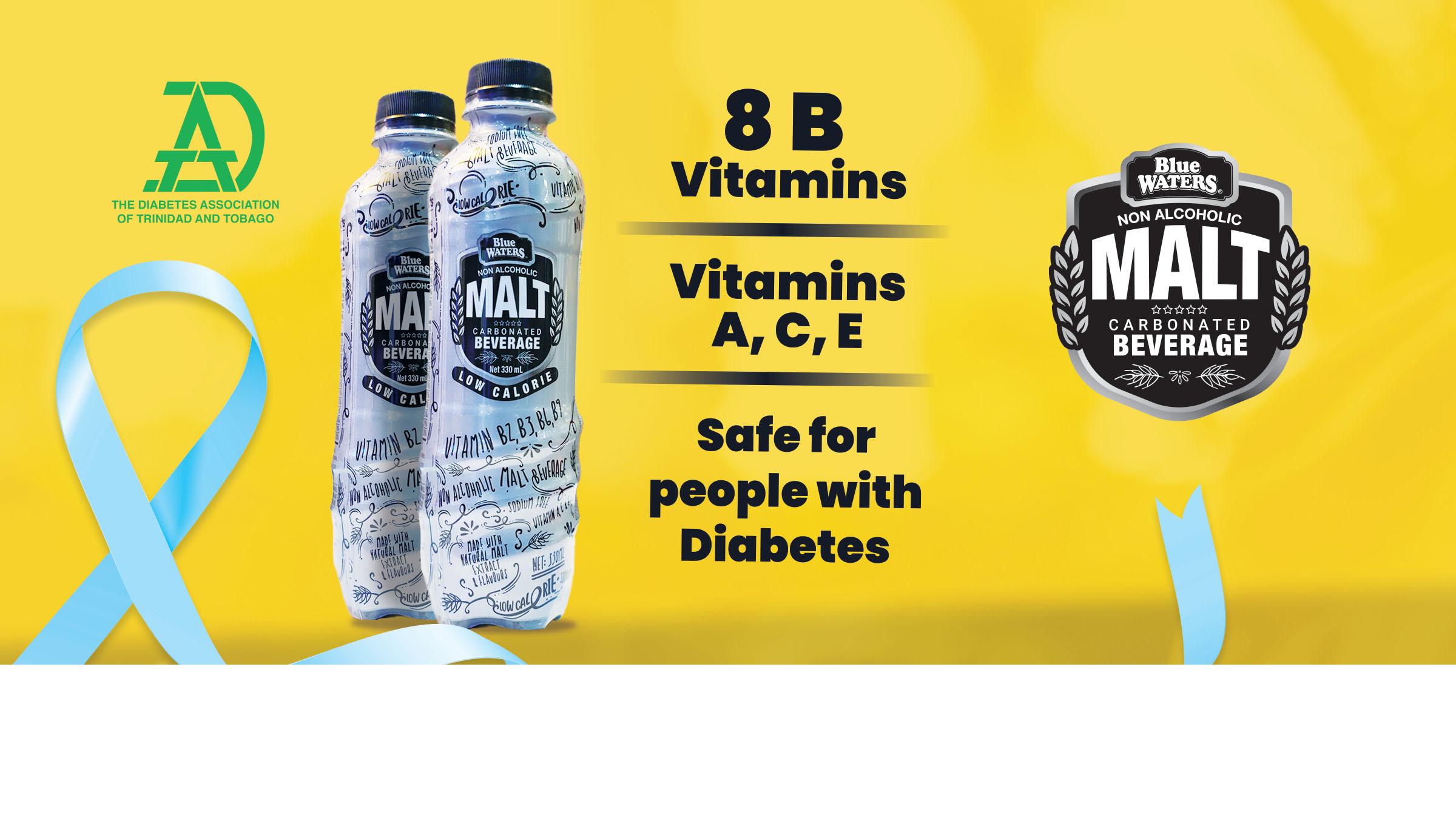


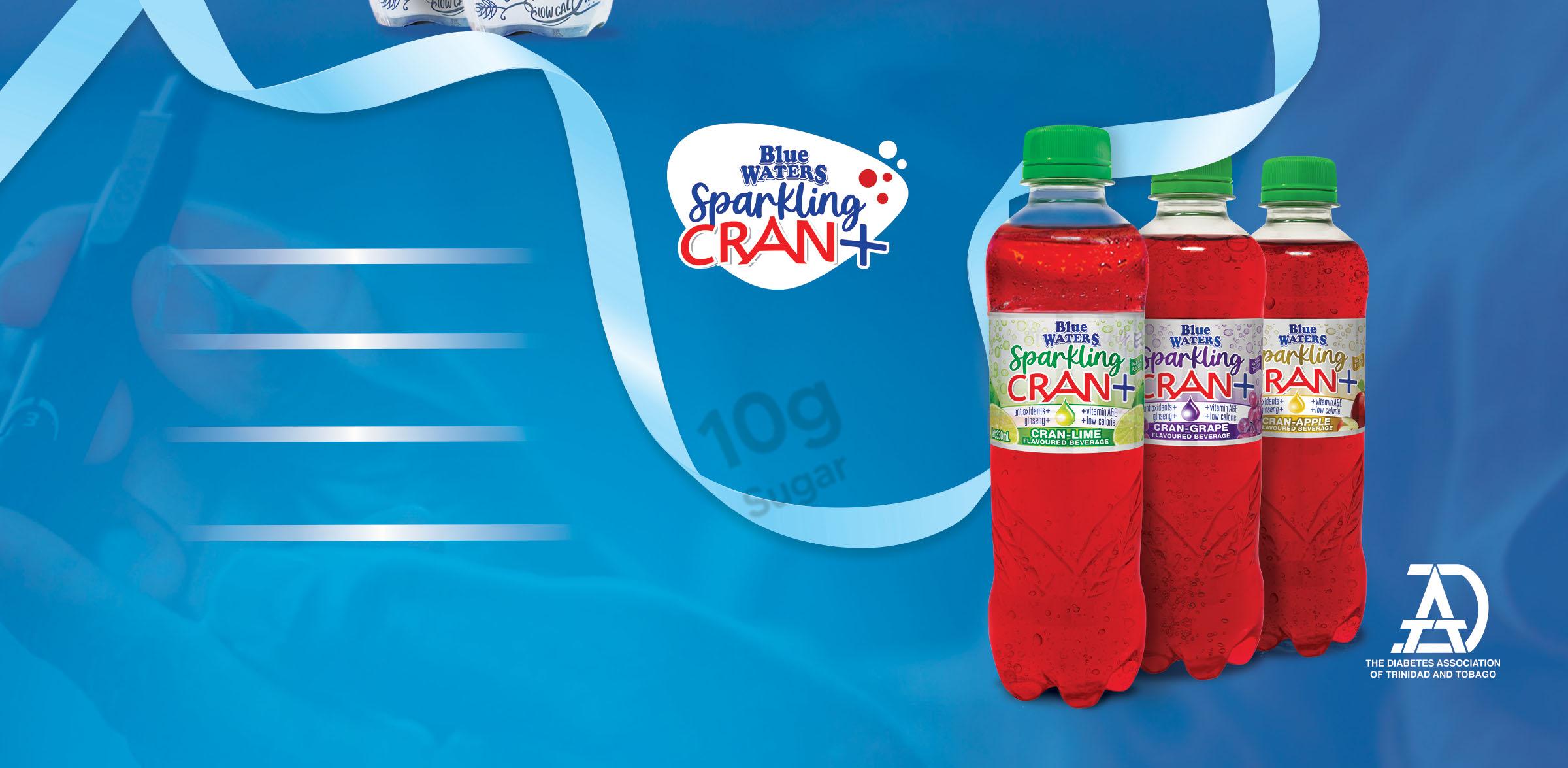





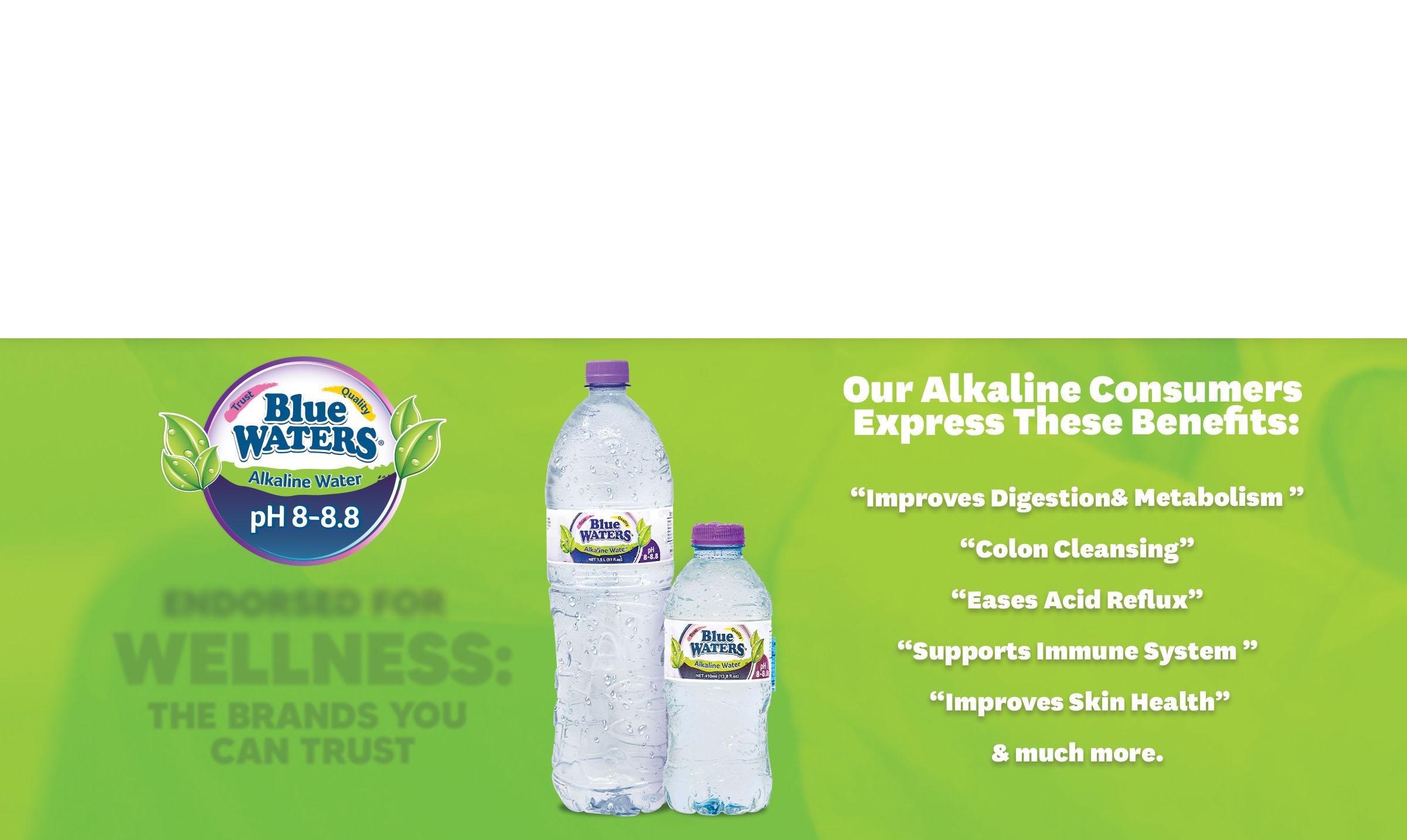






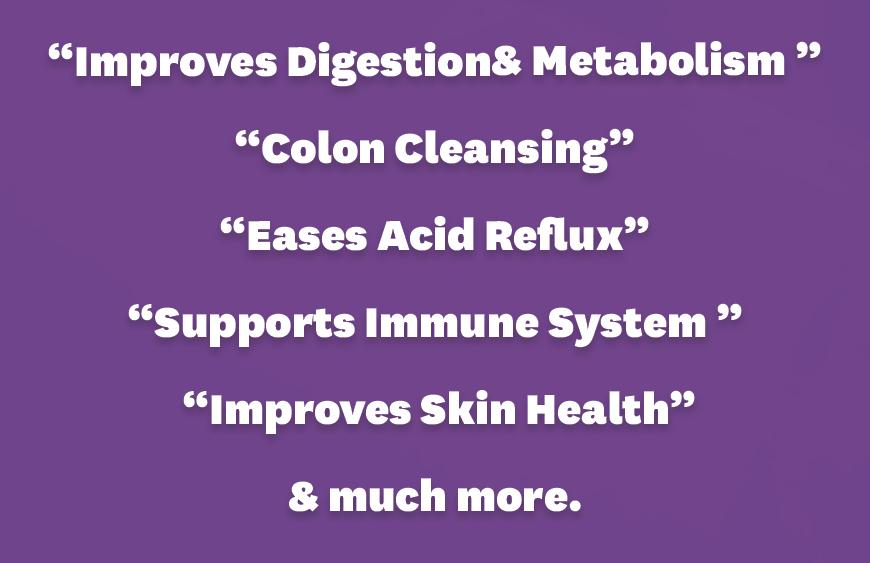
The Tonka Bean A Fragrant Jewel in Gourmet Cuisine
WRITTENBY SHERINE MUNGAL
The Tonka bean, derived from the seeds of the Dipteryx odorata tree, is one of the culinary world’s best-kept secrets. Native to the lush forests of South America, particularly in Venezuela, Brazil, Guyana, and Trinidad and Tobago, the Tonka bean has captivated chefs and perfumers alike for centuries. With its deep, complex aroma, a blend of vanilla, cherry, almond, and subtle spices, the bean has carved out a niche in gourmet cuisine and fine fragrance creation.
A Brief story
Historically, Tonka beans were used by indigenous Amazonian tribes in rituals and as natural remedies. The beans became highly valued in 19th-century Europe, especially in the perfume industry, where their sweet, heady scent made them a prized ingredient. Today, while their culinary use is restricted in some countries due to their naturally occurring coumarin content, regulated use of the bean is permitted in many parts of the world and embraced by high-end chefs and chocolatiers.
Tonka Bean in Gourmet Cuisine
The Tonka bean has become a quiet star in fine dining. Often grated like nutmeg, just a small amount infuses dishes with a luxurious aroma and flavor.
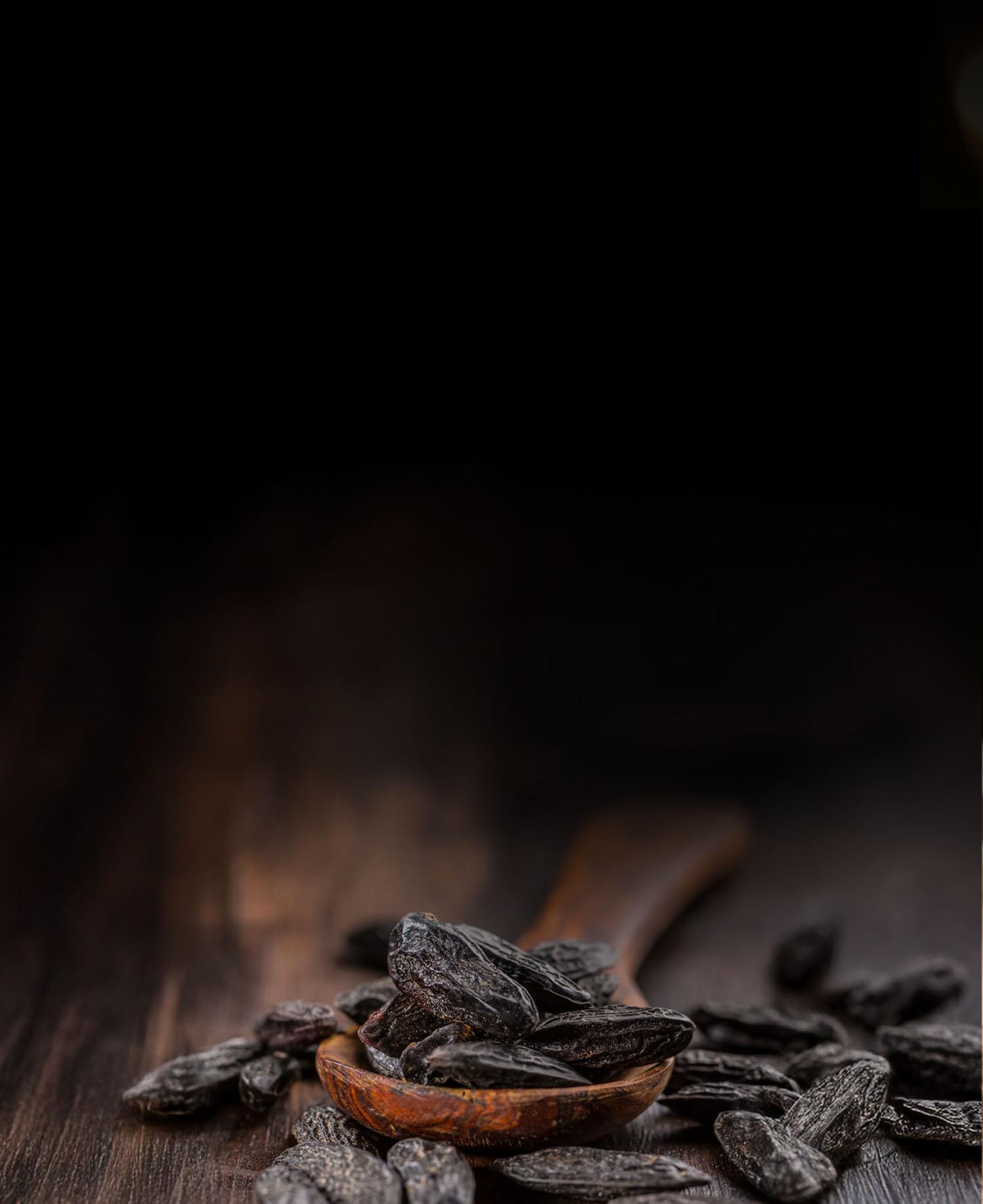
Chefs use it to elevate:
• CUSTARDS AND CREAMS: Tonka adds depth to crème brûlée, panna cotta, and pastry creams.
• CHOCOLATES: Chocolatiers pair Tonka with dark chocolate to enhance its richness and complexity.
• ICE CREAMS AND SORBETS: The bean’s aromatic qualities make for unforgettable frozen desserts.
• BAKED GOODS: Cakes, tarts, and shortbread cookies are given a gourmet touch with a hint of Tonka.
• SAVORY DISHES: Though less common, Tonka can be used in sauces for duck, foie gras, or spiced marinades.
Its flavor profile is so unique that many chefs describe it as “vanilla, but with soul.”
Health Benefits
Tonka beans contain coumarin, a natural compound with potential health-promoting properties when used sparingly:
• ANTI-INFLAMMATORY: Coumarin has been linked to the reduction of inflammation and mild pain relief.
• ANTIOXIDANT: The bean’s compounds may help fight oxidative stress, supporting overall wellness.
• AROMATHERAPY: Tonka’s scent is said to relieve stress, anxiety, and even insomnia, making it a favorite in holistic wellness circles.

NOTE: High doses of coumarin can be harmful to the liver. Tonka beans should be used in moderation and never consumed raw or in large quantities.
Tonka Bean Crème Brûlée
Ingredients:
• 2 cups heavy cream
• 1 Tonka bean (finely grated, about 1/8 tsp)
• 5 large egg yolks
• 1/4 cup granulated sugar (plus extra for topping)
• 1 tsp vanilla extract
• Pinch of salt
Instructions:
1. Preheat oven to 325°F (160°C).
2. Heat the cream and grated Tonka bean in a saucepan over medium heat until just steaming do not boil. Remove from heat and let steep for 10 minutes.
3. Whisk egg yolks, sugar, vanilla, and salt in a mixing bowl until smooth and pale.
4. Slowly add the warm cream to the yolk mixture, whisking constantly to avoid curdling.
5. Strain the mixture through a fine sieve into a measuring cup or jug.

6. Pour the mixture into ramekins and place them in a baking dish. Fill the dish with hot water halfway up the ramekins.
7. Bake for 35–40 minutes or until the centers are just set.
8. Cool to room temperature, then refrigerate for at least 4 hours (or overnight).
9. Before serving, sprinkle a thin layer of sugar on top and caramelize using a kitchen torch or broiler.
Serving suggestion:
Garnish with edible flowers or serve alongside fresh berries for a luxurious dessert.
From high-end desserts to handcrafted chocolates and elegant savory dishes, the Tonka bean continues to be a beloved ingredient in gourmet circles. This little bean brings magic to the plate when used with care and creativity.
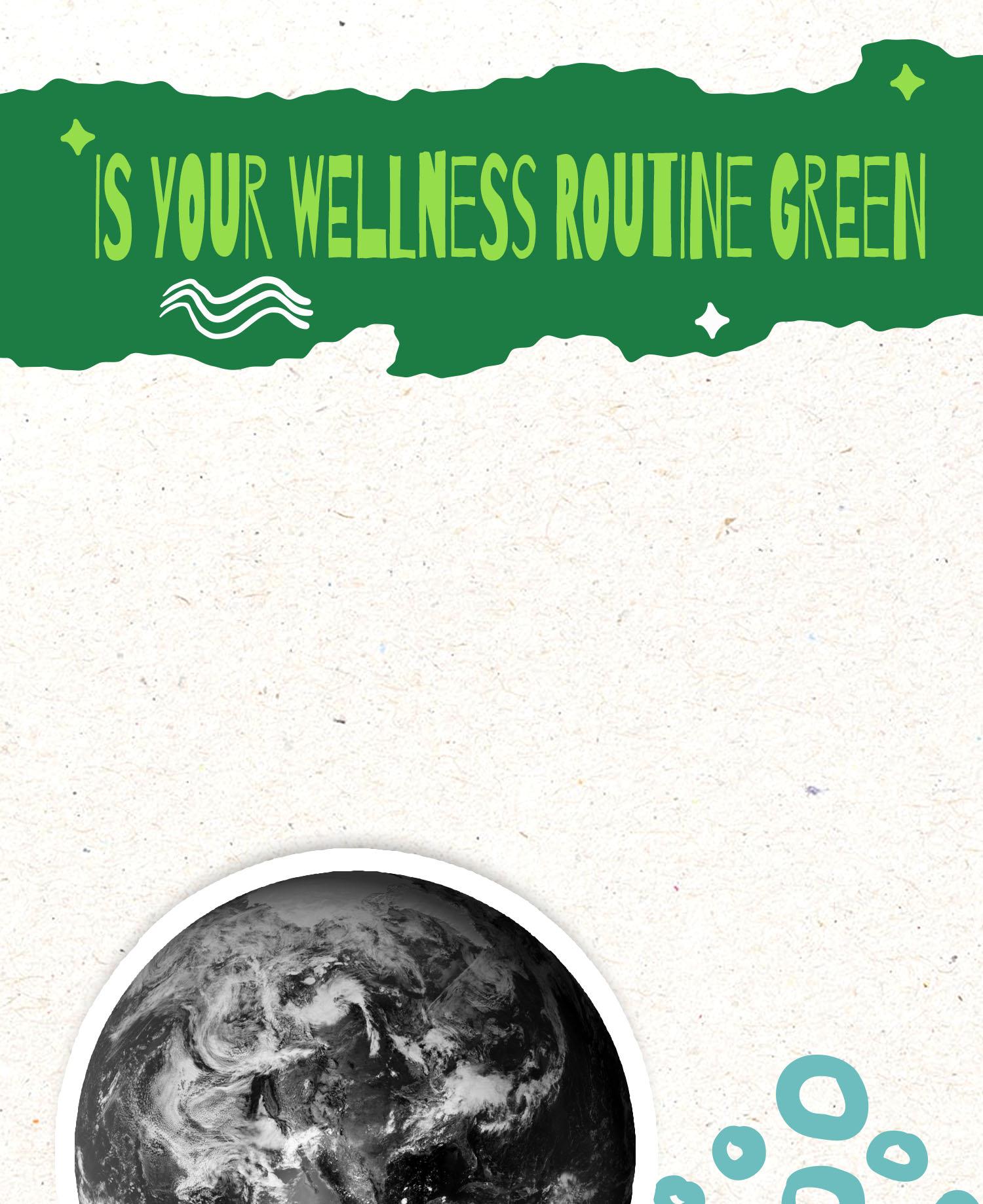
FROM ECO-FRIENDLY YOGA MATS TO “ALL-NATURAL” SUPPLEMENTS AND CRUELTY-FREE SKINCARE, THE HEALTH AND WELLNESS INDUSTRY HAS GONE GREEN AT LEAST ON THE SURFACE. BUT BEHIND MANY OF THESE FEEL-GOOD CLAIMS IS A GROWING PROBLEM: GREENWASHING.
GREENWASHING IS THE PRACTICE OF MARKETING PRODUCTS OR SERVICES AS ENVIRONMENTALLY FRIENDLY OR ETHICALLY RESPONSIBLE WHEN, IN REALITY, THEY ARE NOT. IT’S A DECEPTIVE TACTIC USED BY COMPANIES TO APPEAR SUSTAINABLE AND SOCIALLY CONSCIOUS WITHOUT MAKING MEANINGFUL CHANGES TO THEIR PRACTICES OR SUPPLY CHAINS.
IN THE BOOMING GLOBAL WELLNESS MARKET, ESTIMATED TO BE WORTH OVER $5 TRILLION, GREENWASHING HAS BECOME ESPECIALLY PREVALENT. CONSUMERS ARE DEMANDING HEALTHIER, CLEANER, AND MORE ETHICAL OPTIONS, AND BUSINESSES ARE EAGER TO CASH IN. BUT WITHOUT PROPER REGULATION OR TRANSPARENCY, IT’S INCREASINGLY DIFFICULT TO SEPARATE GENUINE SUSTAINABILITY FROM CLEVER BRANDING.
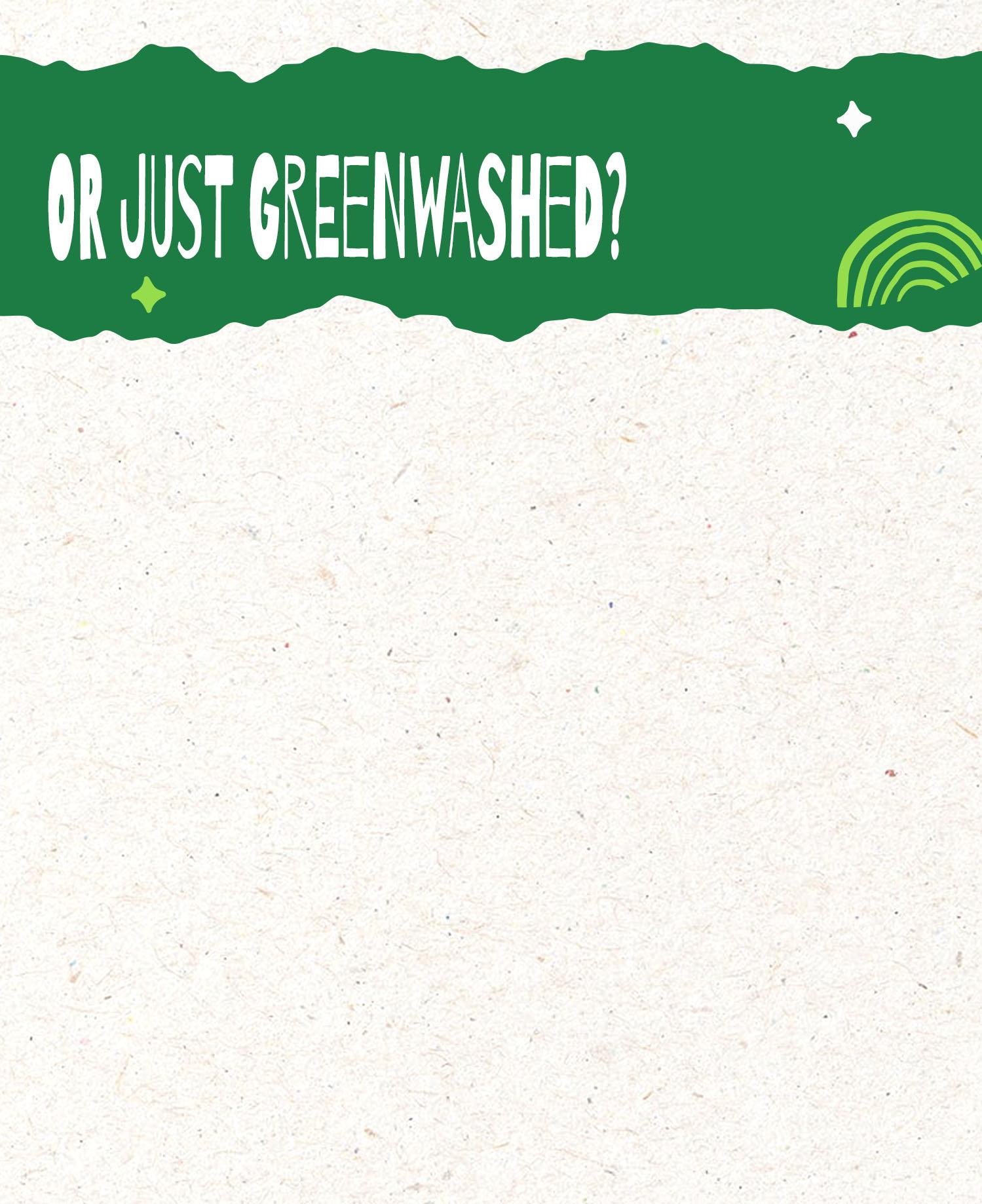
What Does Greenwashing Look Like?
Greenwashing takes many forms in the health and wellness space. Some common examples include:
• Vague Labels: Words like “natural,” “non-toxic,” “eco,” or “green” are often used without any defined standard. A product labeled “clean” might still contain synthetic chemicals or be packaged in non-recyclable plastic.
• False Certifications: Some brands invent their own eco-labels or use misleading logos that mimic legitimate environmental certifications, such as USDA Organic or Leaping Bunny.
• Minimal Changes, Maximum Marketing: A company may promote one sustainable feature, like a recycled cap or reduced packaging while ignoring much larger environmental harms, such as high emissions from production or unsustainable sourcing.
• Health Halo Effect: Products in green-colored packaging or minimalist designs often appear healthier or more sustainable, even if the ingredients or manufacturing practices say otherwise.
Why It Matters
Greenwashing is more than just a marketing issue; it has real consequences. First, it undermines consumer trust. When people spend more on products, they believe are ethical or sustainable, only to find out they’ve been misled, it breeds skepticism and discourages conscious shopping.
Second, it diverts attention and money away from genuinely sustainable brands. Small businesses that invest in ethical sourcing, clean ingredients, and eco-conscious packaging struggle to compete with larger companies using greenwashing tactics to dominate shelf space.
Third, and most importantly, greenwashing slows down progress. If companies can meet consumer expectations through marketing spin instead of real change, there is little incentive to reduce carbon emissions, eliminate harmful chemicals, or improve labor conditions in global supply chains.
Greenwashing in the Caribbean Context
In the Caribbean, where issues like plastic pollution, biodiversity loss, and climate vulnerability are deeply felt, greenwashing poses an added threat. Consumers across the region are becoming more aware of environmental and health issues, but regulatory frameworks around labeling and marketing are still evolving.
Imported health and wellness products often carry misleading claims, and local brands sometimes adopt green aesthetics without clear commitments to sustainability. Without stricter guidelines, it becomes difficult for consumers to make truly informed choices.
What You Can Do as a Consumer
Combatting greenwashing starts with awareness. Here are a few ways you can protect yourself and make more responsible purchases:
• Read Ingredient Lists: Don’t rely on the front of the package. Turn it around and read what’s actually inside.
• Look for Legitimate Certifications: Trusted labels like USDA Organic, Ecocert, Fair Trade, or Certified B Corporation offer verified proof of environmental or ethical standards.
• Research the Brand: Visit company websites and check whether they publish sustainability reports, ingredient sourcing details, or third-party audits.
• Ask Questions: Don’t hesitate to reach out to brands about their practices. Honest companies will respond transparently.
• Support Local, Sustainable Brands: Many Caribbean-based businesses are genuinely committed to sustainability. Supporting them helps create a stronger, greener local economy.
Final Thoughts
The rise of health and wellness is a positive trend, but only if it’s backed by truth, not just trendiness. As consumers, we have the power to demand better. Greenwashing may offer a pretty picture, but true wellness, both personal and planetary, requires integrity.
Let’s not settle for appearances. Let’s go deeper, shop smarter, and hold the industry accountable.
WRITTEN BY AMIRA CHENELLE M.
WHAT THE VAPE!? 10 SHOCKING 0
WRITTEN BY STAFF WRITER
1. E-CIGARETTE AEROSOL CONTAINS TOXIC COMPOUNDS.
Vaping produces aerosols that can contain formaldehyde, acetaldehyde, and acrolein chemicals known to damage lung tissue and DNA.
2. MOST VAPE LIQUIDS CONTAIN NICOTINE.
Nicotine is a highly addictive stimulant that increases heart rate and blood pressure and can alter brain development in young users.
3. DIACETYL HAS BEEN FOUND IN FLAVORED VAPES.
Diacetyl, used in buttery flavors, has been linked to bronchiolitis obliterans also known as “popcorn lung,” a serious and irreversible lung condition.
4. HEAVY METALS ARE PRESENT IN VAPOR.
Studies have detected lead, nickel, and chromium in e-cigarette aerosols, likely from heated coils, posing long-term health risks.
5. PROPYLENE GLYCOL AND GLYCERIN MAY DEGRADE INTO TOXINS.
When heated, these common vape liquid bases can break down into formaldehyde and acetaldehyde both classified as probable human carcinogens.
6. VAPING AFFECTS IMMUNE FUNCTION.
Exposure to e-cigarette vapors has been shown to impair white blood cell activity, reducing the body’s ability to fight infection.
7. VAPING INCREASES OXIDATIVE STRESS.
Inhaled aerosols can disrupt cellular balance, leading to inflammation and increased risk of cardiovascular and pulmonary diseases.
8. IT CAN ALTER GENE EXPRESSION.
Research indicates that e-cigarette exposure may modify the expression of genes involved in lung function and immune response.
9. ULTRAFINE PARTICLES REACH DEEP INTO THE LUNGS.
The aerosolized particles in vapes are small enough to penetrate alveoli and enter the bloodstream, where they may contribute to systemic inflammation.
10. THE LONG-TERM HEALTH EFFECTS ARE STILL UNKNOWN.
Because vaping is relatively new, long-term studies are still underway—but early evidence raises concerns about chronic lung and heart disease.
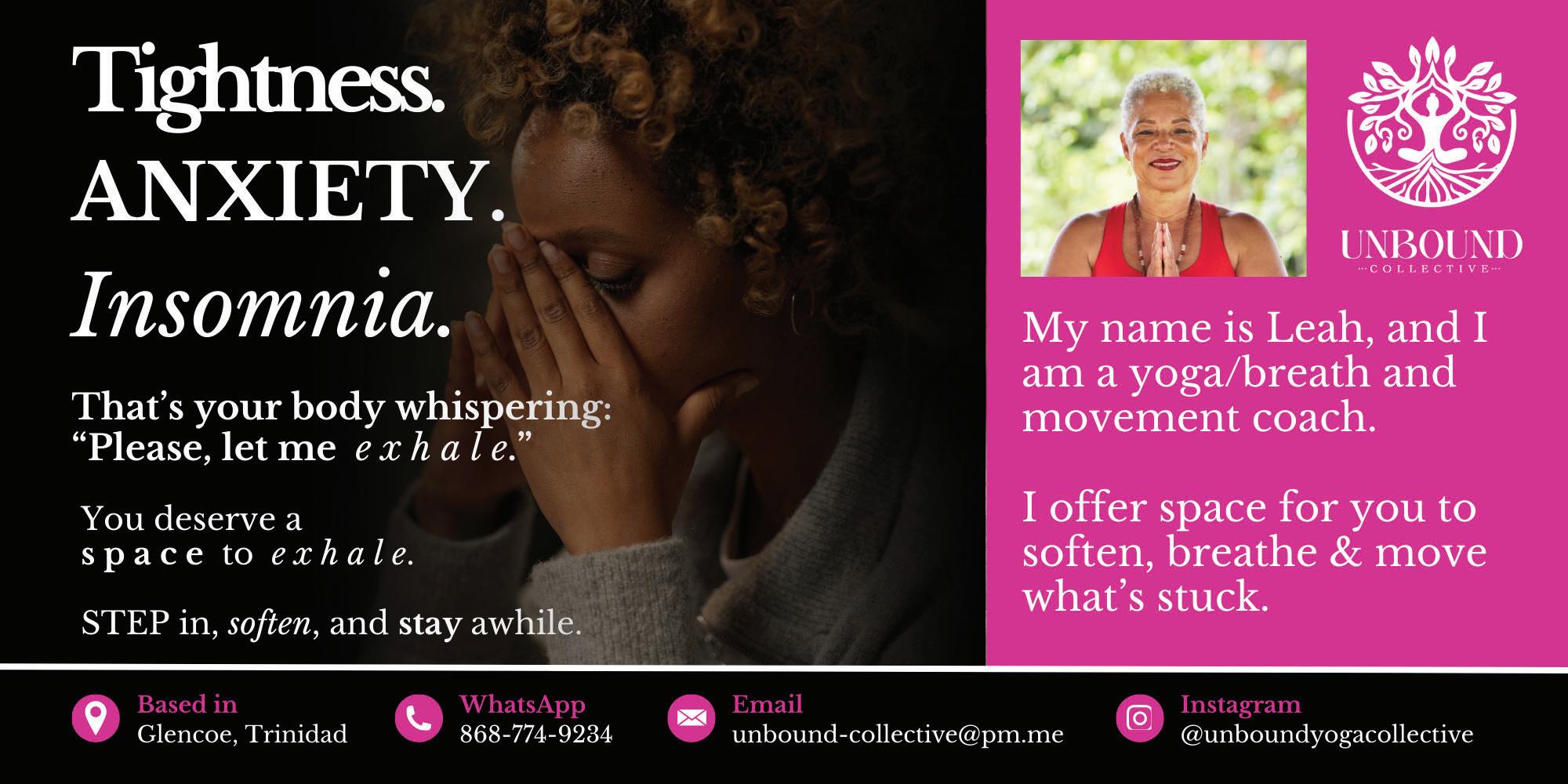
THE NEXT U
July to September 2025
THE BLUE ZONE MINDSET
LONGEVITY LESSONS FROM THE WOR LD’S HEALTHIEST COMMUNITIES.
Other articles:
Rethinking Rest
It’s not just sleep. It’s strategy.
Ultra-Processed Panic
Why convenience foods are costing us our health.
Article submission guidelines
U strives to provide informative, educational articles emphasizing health and lifestyle in the Caribbean. We select articles that will appeal to our Caribbean audience that are uplifting, informative and pertinent to health and wellness.
Policies
U The Caribbean Health Digest retains the right and complete ownership of the articles written and published here. This means that if we publish your work in U, we can also publish in any another publication that we may choose, we will however always give credit to all our writers.
All articles are accepted on speculation. Publication of any article cannot be guaranteed. U reserves the right to edit all copy.
Specifics
All accepted articles will be accompanied by the byline and monetary compensation as set out in our writers’ contract.
Letters to the editor
We encourage Letters to the Editor commenting on recent articles published in our magazine. They are not peer reviewed as such, but are assessed in-house to make sure they are factual and non-inflammatory, etc.
Submit all comments, letters and/or subscription requests to:
U The Caribbean Health Digest, Highway Plaza, Level 2, West Wing LP #80 Calcutta Settlement Road No. 1, Freeport, Trinidad & Tobago or email us at register@uhealthdigest.com
www.uhealthdigest.com
Advertising. P: 868-280-3353 + 4536
